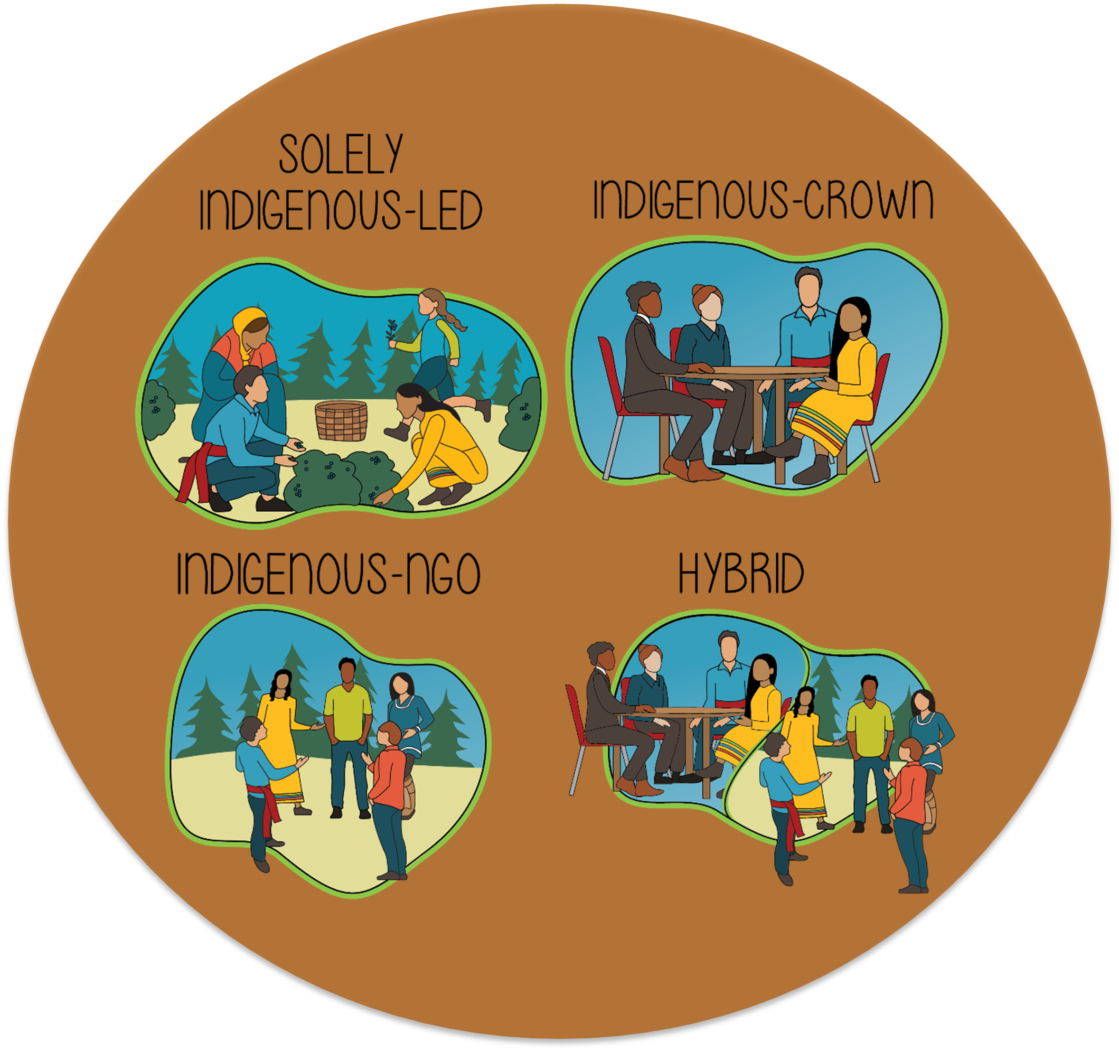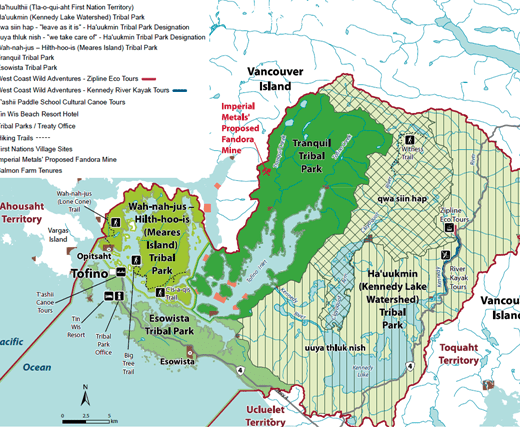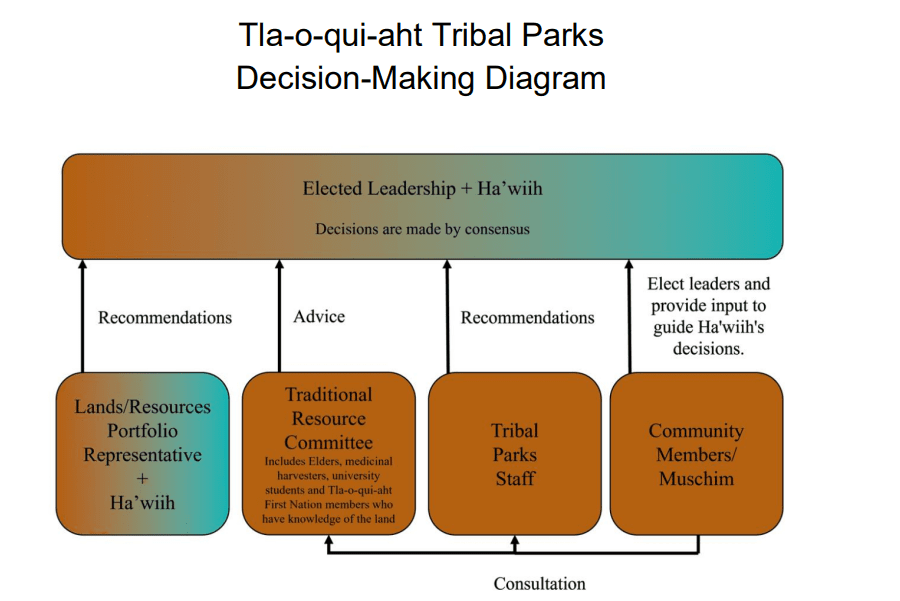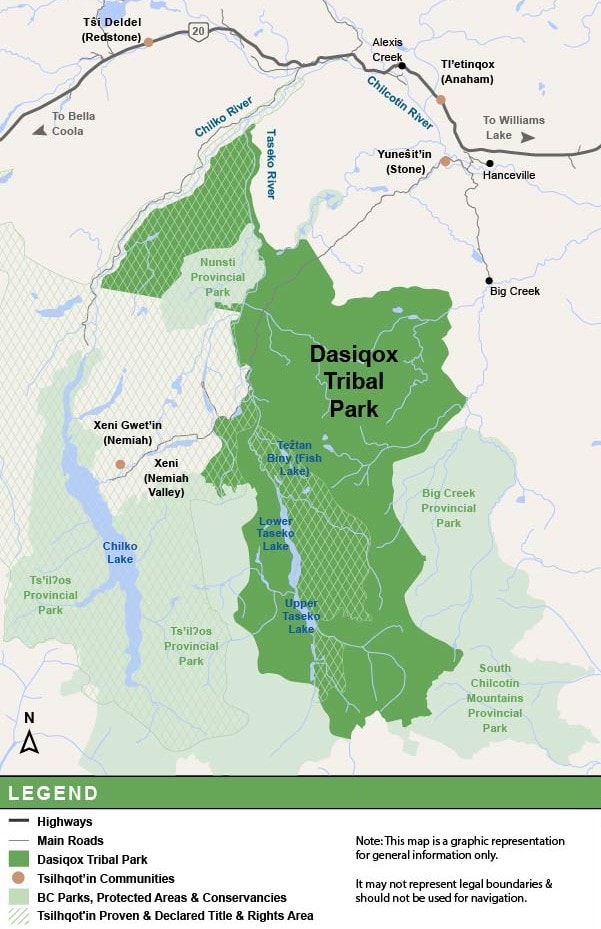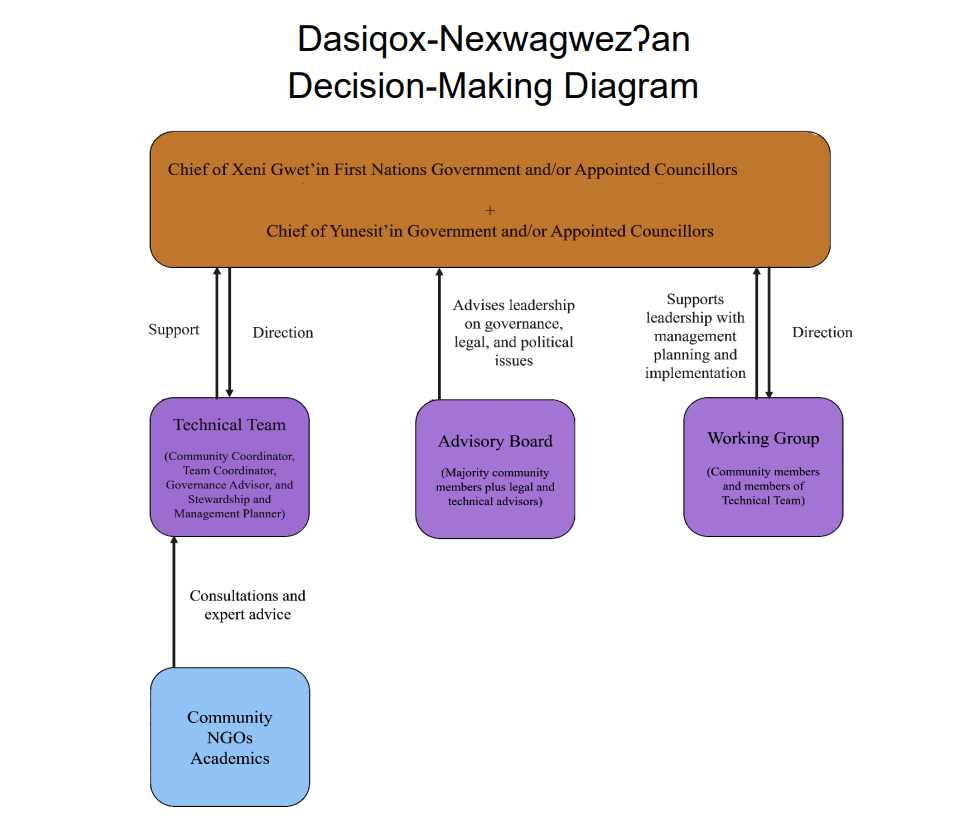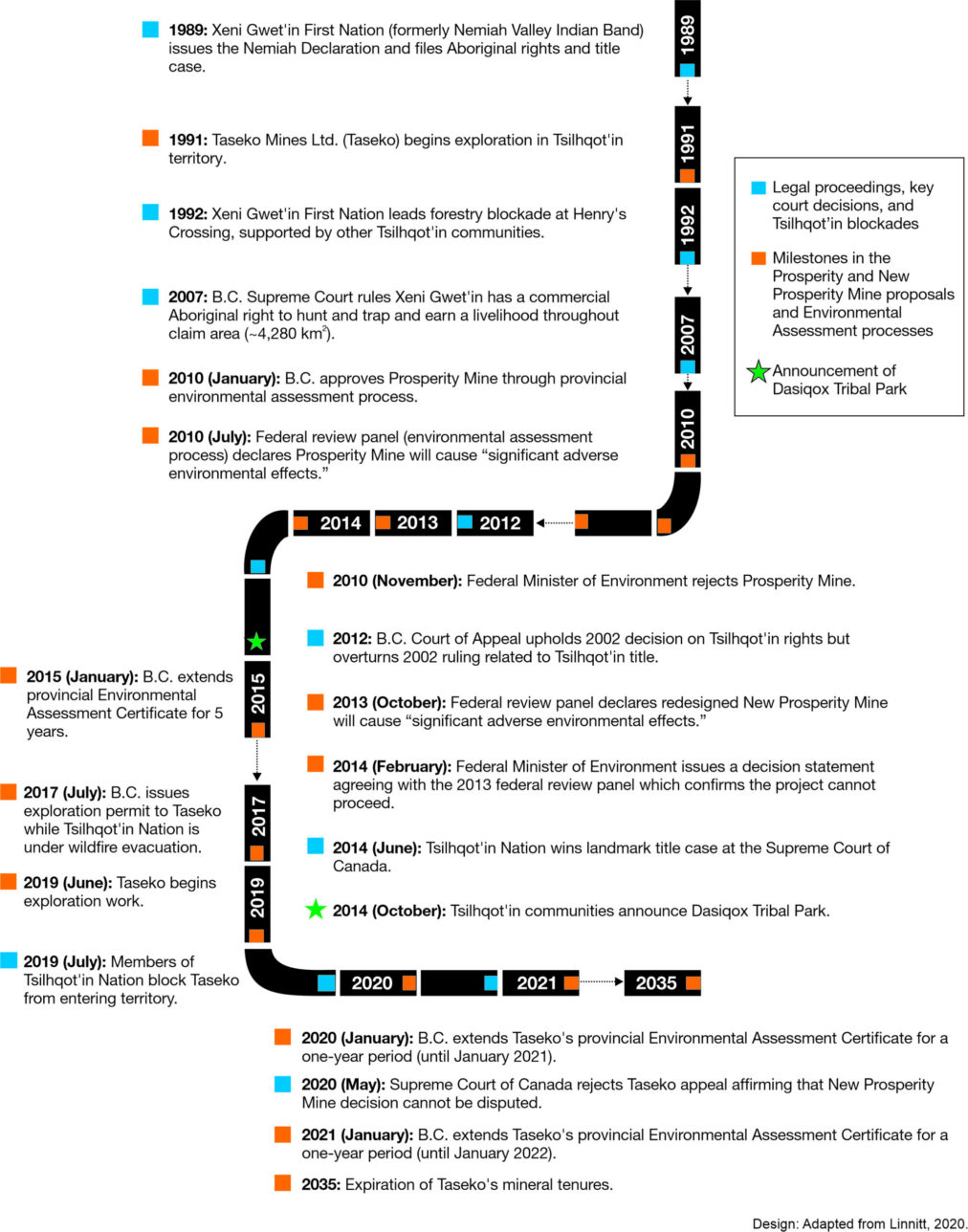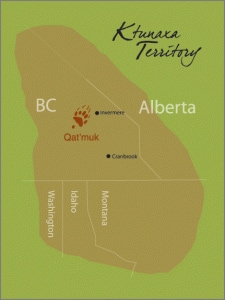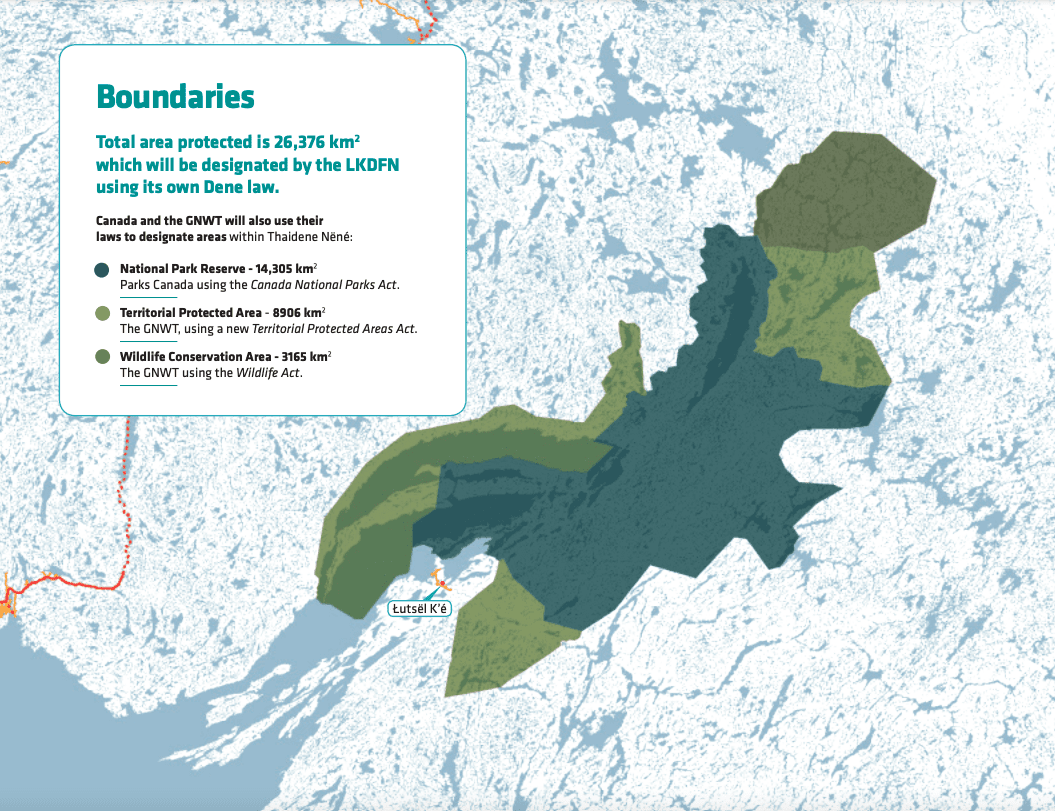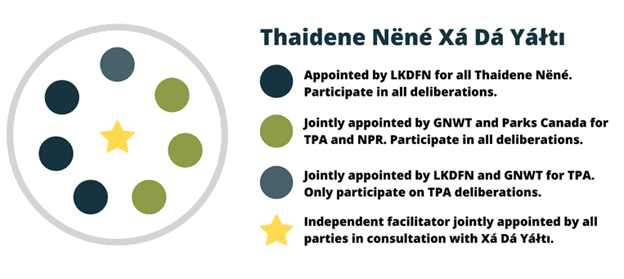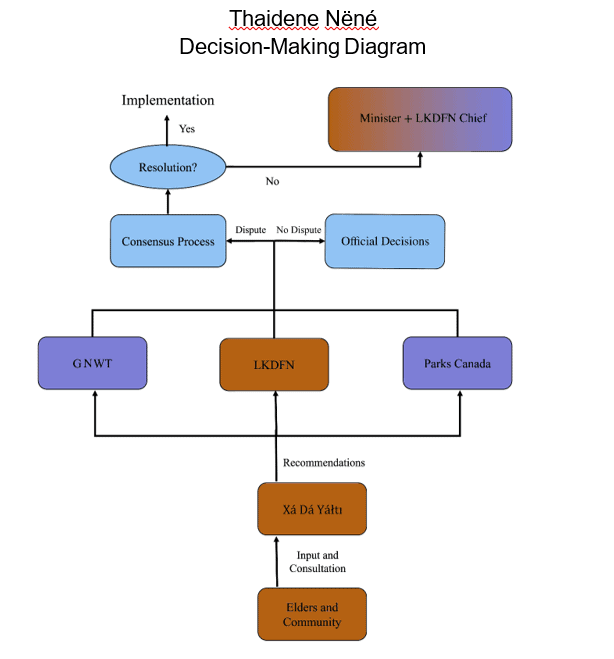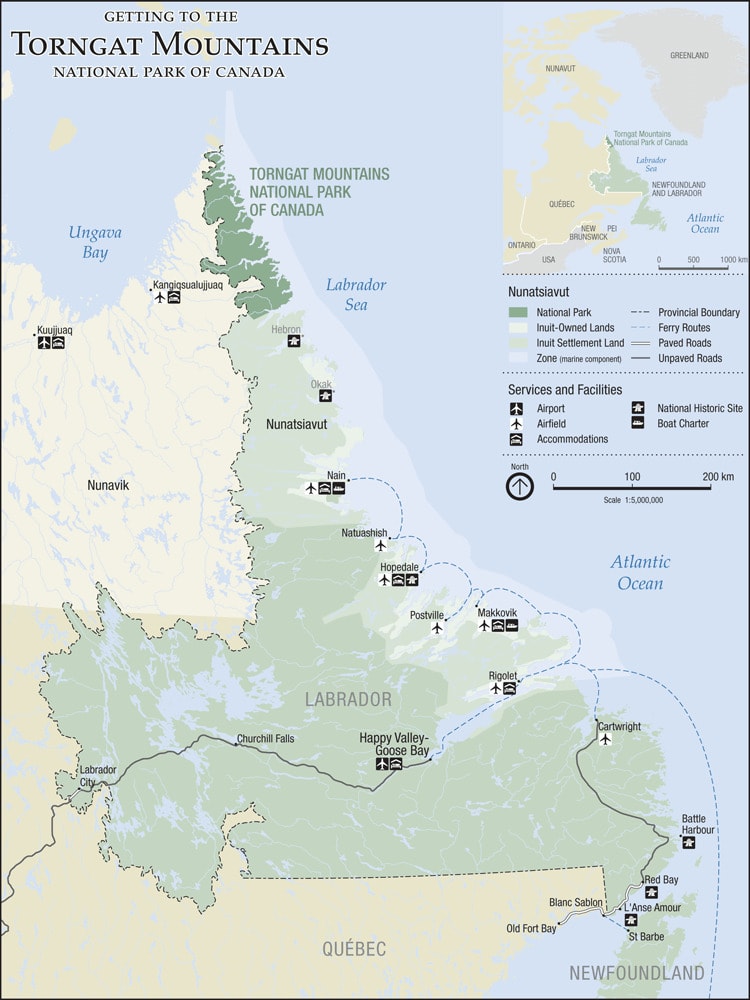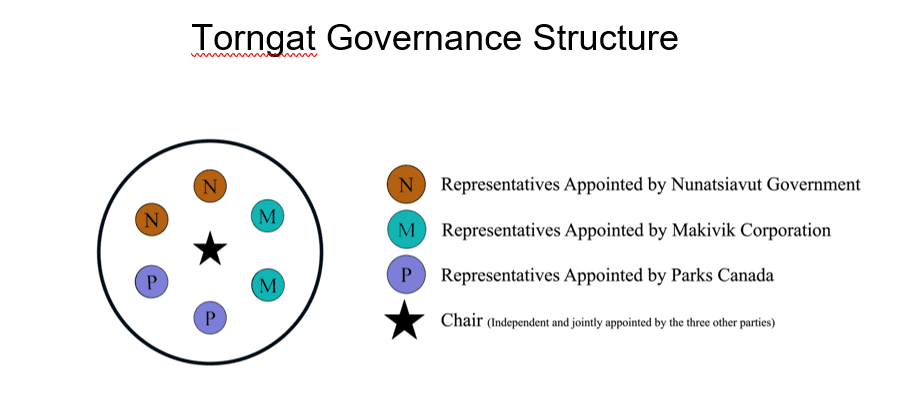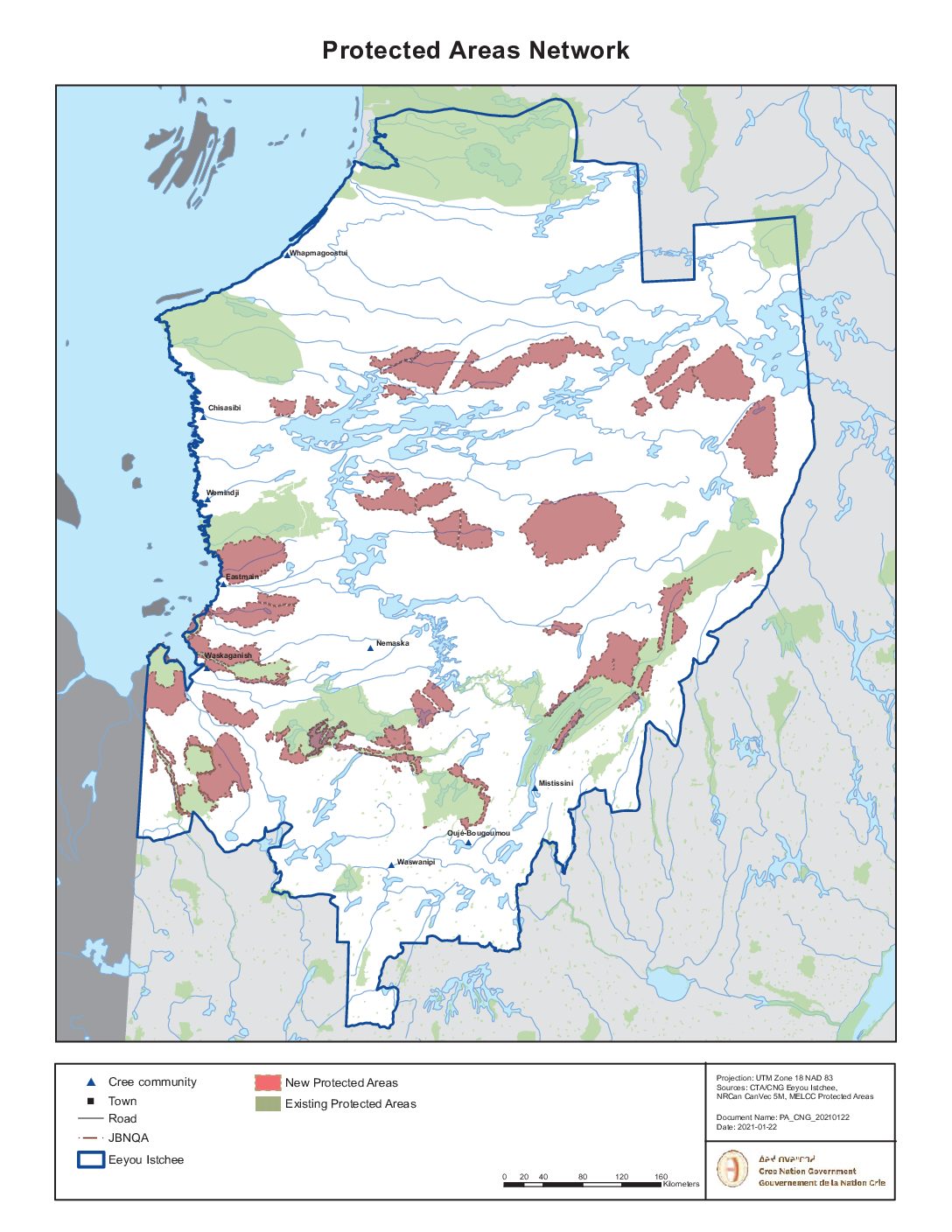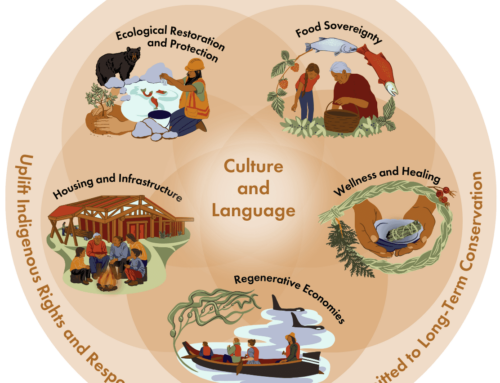IPCA Governance Models: A Snapshot of Existing Conservation Governance Arrangements
Prepared by: Megan Youdelis
With contributions from:
Eli Enns and Terry Dorward (Tla-o-qui-aht Tribal Parks); Justine Townsend, Jonaki Bhattacharyya, Roger William, and Russell Myers Ross (Dasiqox-Nexwagwez?an); Kerri Garner (Qat’muk); Steven Nitah (Thaidene Nëné); Martin Lougheed and Judy Rowell (Tongait KakKasuangita SilakKijapvinga / Torngat Mountains National Park); and Chantal Tetreault (Eeyou Istchee Protected Area Network).
This work is licensed under a Creative Commons Attribution-NonCommercial-ShareAlike 4.0 International License.
Publication Date: February 2023
Introduction
This resource is intended for Indigenous Nations and governments who are interested or currently engaged in the creation of an Indigenous Protected and Conserved Area (IPCA) or other Indigenous-led conservation initiatives. It provides a snapshot of how IPCAs are being governed across what is now known as Canada.
The journeys of IPCAs are evolving. We want to emphasize that IPCAs symbolize not only what has been accomplished and what currently exists, but also what is possible.
Each IPCA, or Indigenous-led initiative, includes information on the governance structure, decision-making processes, laws, management planning, alliances, and partnerships that help to govern and care for the lands, waters, and species in each territory. Every example includes a discussion of how decisions are made, and by whom, as well as a brief history of the initiative.
While the key snapshot of information for each example is displayed up front, each section also provides additional context for a more in-depth exploration of the IPCA or conservation initiative in question. This resource also includes key opportunities, challenges, and advice to other Indigenous governments considering pursuing IPCAs.
We are grateful to the representatives of each initiative who shared input and reviewed their stories before publication.
The governance models featured in this resource represent two of the four governance categories outlined by the Indigenous Circle of Experts in their report, We Rise Together. To navigate this resource, click on the governance models below, or click on the table of contents above for comprehensive details into each IPCA or Indigenous-led conservation initiative.
This guide will be updated as more IPCA governance examples and stories are documented and shared.
Each governance model falls into two of the following four categories, outlined by the Indigenous Circle of Experts in their report, We Rise Together:
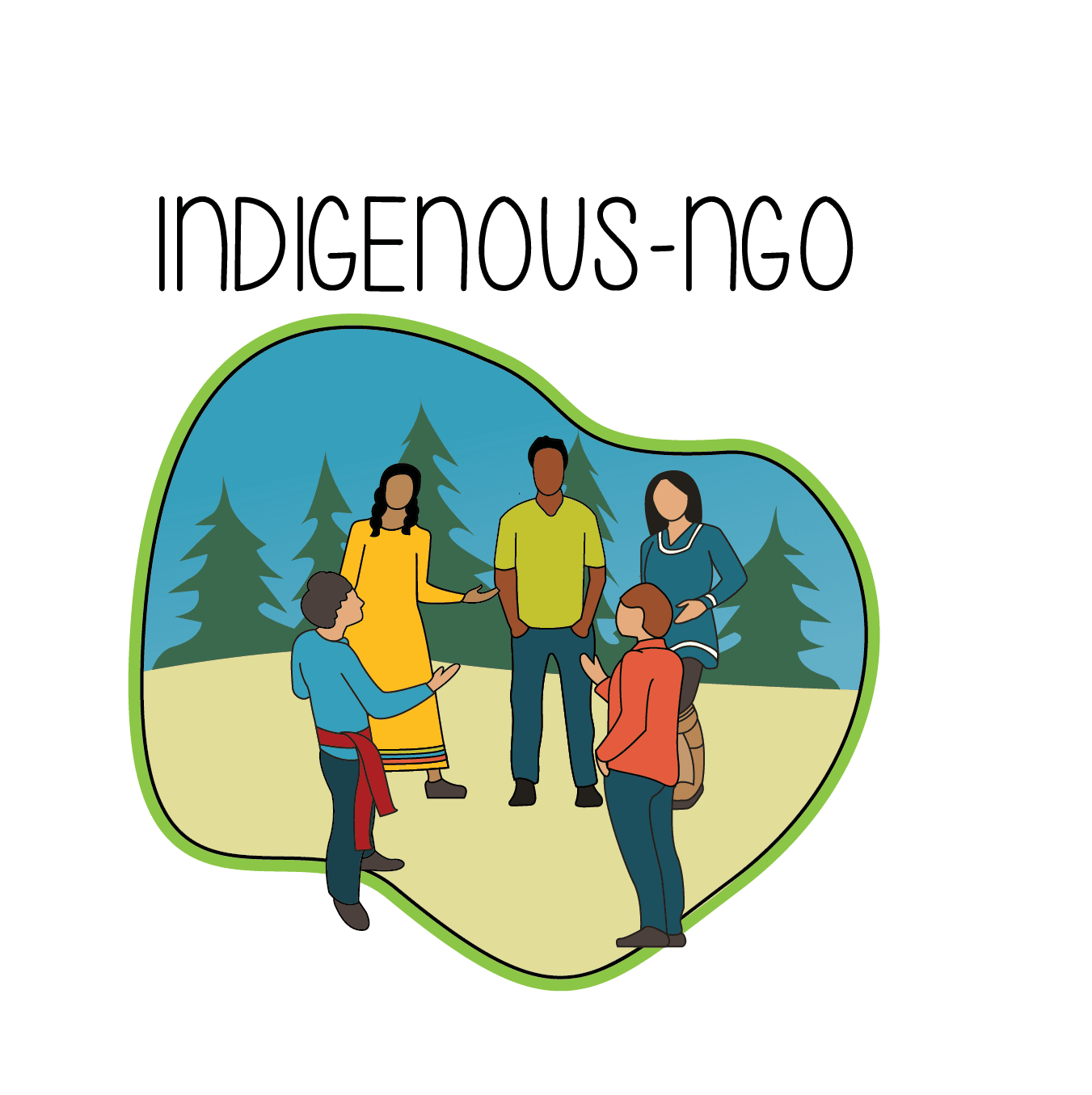
IPCA is governed primarily by Indigenous Nation/Government in partnership with a non-governmental organization*

IPCA is governed primarily by Indigenous Nation/Government in partnership with a mix of Crown agencies and non-governmental organizations*
*Currently there are no documented examples of IPCAs that are operating under the Indigenous-Non-Governmental Organization and Hybrid governance models that the authors are aware of. This guide will be updated as more IPCA governance examples and stories are documented and shared.
Acknowledgements
The Governance Stream of the Conservation through Reconciliation Partnership would like to express gratitude to all the contributors to this project for taking the time to share their insights and experiences with IPCA governance in their territories.
Thanks to Megan Youdelis, for taking on the role of lead author and doing the work that made this project possible.
Special thanks to Justine Townsend, Jonaki Bhattacharyya, Robin Roth, Allison Bishop, and members of the Conservation through Reconciliation Governance Stream for helping to scope and direct the project from start to finish.
The work of Kristy Tomkinson, Elena McCulloch, and Design De Plume in editing, logistical support, artistic design, and web development has been invaluable in executing on the vision of the project. Thanks to Conservation through Reconciliation Partnership for funding the production of this project.
Solely Indigenous-led

Tla-o-qui-aht Tribal Parks
Snapshot
Lead Government: Tla-o-qui-aht First Nation
Governance Model: Solely Indigenous-led
Established: Wah’na’juss Hilth’hoo’iss (Meares Island Tribal Park) was declared in 1984, followed by Ha’uukmin in 2007, and Eel-suk-Kiss/Onadsilth Tribal Park and Esowista Tribal Park in 2013. Read more about establishment by visiting the Establishment Section.
Location: Clayoquot Sound on the West Coast of Vancouver Island, B.C.
Approximate Size: In adherence to Nuu-chah-nulth knowledge systems, the size of Tla-o-qui-aht Tribal Parks has not been calculated and/or documented.
Quick Facts:
- Governed collaboratively by elected and hereditary leadership.
- Plans are underway to develop additional governing body called the ‘Tribal Park Society’.
- Protects the entirety of Tla-o-qui-aht territory, including natural watershed areas, old-growth forests, and culturally significant areas.
- Secured ecosystems and old-growth forests threatened by logging and mining.
Website: https://tribalparks.com/
Learn more from the Tla-o-qui-aht Tribal Parks Story.
Video: Tla-o-qui-aht Tribal Parks (2021)
Map:
A map of Tla-o-qui-aht First Nation Territory, featuring Wah’na’juss Hilth’hoo’iss, Ha’uukmin, Eel-suk-Kiss/Onadsilth and Esowista Tribal Parks.
Source: Tribal Parks Website.
Governance Details
Who makes decisions?
The Tribal Parks governance system brings together hereditary and elected leadership. The Tribal Parks initiative is a Band Council program, but governance also requires the Ha’wiih (the hereditary leaders) who work to fulfil their stewardship responsibilities.
The Tla-o-qui-aht have eleven reserves where the Band Council has jurisdiction, but the Ha’wiih have a broader mandate of responsibility to uphold Nuu-chah-nulth laws and values throughout the entire territory. The Council includes 11 Councillors and one Chief. There are five Ha’wiih: Hiyoueh, Hiisquuishsinuptshilth, Muuchinink, Naakqwiimulthnii, Nuumiis.

Diagram: A diagram of the Tla-o-qui-aht Tribal Parks governance system, which is composed of 11 Councillors, one Chief, and six Ha’wiih.
How are decision-makers determined?
Chief and Council are elected and each serve a four-year term. The Ha’wiih have inherited rights and responsibilities for life.
How are decisions made?
Elected leadership and the Ha’wiih sit at the same table and make decisions by consensus. When issues come to the combined leadership table, all are welcome to provide input and participate in decision-making.
Tla-o-qui-aht consensus does not mean that everyone must agree on a particular direction that Tribal Parks is taking, but rather, whether or not they can live with the outcome. Controversial issues relating to Tribal Parks are resolved through a process where all facts and opinions are presented and debated by the combined leadership.
Decision-making is supported by Tribal Parks staff who offer advice and at times bring in experts on certain issues. Decision-making is further supported by the Traditional Resource Committee which includes Elders, medicinal harvesters, university students, and Tla-o-qui-aht First Nation members who are on the lands and waters and have knowledge about resource issues.
The Committee makes recommendations to the collective leadership to inform decisions. Other forms of gathering information on lands/resource issues have included questionnaires and community meetings to gather information from members.
The elected Councillors also put forward a Lands/Resource Portfolio representative who works with an appointed Ha’wiih (or their designated representative or speaker) to put forth recommendations to the combined leadership.
Diagram: A diagram of the the Tla-o-qui-aht decision-making process. Staff, Committee and Portfolio representatives support decisions made by the collective leadership. These decisions are made by consensus.
Conflict Resolution
Traditionally, in the case of a conflict or disagreement on an issue, the Tyee Ha’wiih (head Chief) would receive advice from his sub-Chiefs and Mus’chim (people/community members) to make the final decision. Currently, the majority of the controversial issues in consensus-making initiate a process that involves bringing all issues to the table to be considered, discussed, and debated. Depending on the issue at hand, this process could take years.
Laws and Legislation
The Tribal Parks are designated under Nuu-chah-nulth law. Iisaak is the highest law of the Nuu-chah-nulth constitution, meaning to “observe, appreciate, and act accordingly.” Iisaak and other Tla-o-qui-aht laws motivated the establishment of the Tribal Parks and continue to guide the governance of the parks.
These laws reflect principles such as uiuthluk nish, uiuthluk usmaa, meaning “to take care of ourselves, and to take care of our previous ones.” The declaration of Meares Island Tribal Park was a response to a violation of these laws by the province of British Columbia as well as Canadian constitutional law.
The parks have never been formally recognized by provincial or federal governments, and the Tla-o-qui-aht have not sought designation under Crown legislation. However, the parks are an assertion of Indigenous governance as well as an assertion of rights protected through Section 35 of the Canadian Constitution, and so they can be considered “constitutional parks” (Woodward quoted in Gilchrist, 2016).
Read more about these laws in the Tla-o-qui-aht Tribal Parks Story.
Who are decision-makers accountable to?
All decision-makers are accountable to Tla-o-qui-aht members, youth, and Elders. Chief and Council are elected, and the Ha’wiih’s authority comes from the people as well. If a hereditary leader is not acting in the interest of the collective, members can shift their support to another house and refuse the gifts of the hereditary leader, undermining their authority (Interviews with Eli Enns, IISAAK OLAM Foundation and Terry Dorward, Tla-o-qui-aht Tribal Parks).
Management Plan
The Tla-o-qui-aht have developed an Indigenous Watershed Governance methodology to promote environmental security and sustainable livelihoods. The Tribal Parks include 500-year stewardship, restoration, and community development plans.
Each of the four parks has its own resource management plan laid out in the Tribal Park Declaration. All management plans were developed through comprehensive public consultations and workshops that involved Tla-o-qui-aht Elders and community members as well as nearby First Nations, local non-Indigenous communities, and other interested parties, including government and industry representatives.
The management plan established two management zones: qua’siin’hap, meaning “leave as it is,” and uuya’thluk’nish, meaning “we take care of.” Qua’siin’hap includes old-growth ecosystems and important cultural sites which are off-limits to all development, and uuya’thluk’nish includes areas where low-impact economic initiatives and ecological restoration activities can occur.
Counter-Governance Model
The Tla-o-qui-aht take a strategic and innovative approach to managing the multiple and overlapping jurisdictions within the parks.
The Tribal Parks encompass areas under multiple jurisdictions:
- Esowista Tribal Park overlaps with the Pacific Rim National Park Reserve operated by Parks Canada.
- Clayoquot Sound is a designated United Nations Biosphere Region.
- The Tribal Parks surround and include the tourist town of Tofino, other private property, forestry tenures on provincial land, and provincial parks.
According to this story on Tla-o-qui-aht Tribal Parks:
“Tla-o-qui-aht Tribal Parks have not relied on fighting existing permits and licences such as those permitting old-growth logging. Rather, the Tribal Parks’ strategy is to establish a counter-governance for the area that will eventually render these government-issued permits and licences obsolete and inoperable.” (For more information see: Tla-o-qui-aht Tribal Parks and the Four Moose).
An example of this counter-governance system played out when the Nation received a referral from the province to log some of the remaining old-growth forests. Tla-o-qui-aht representatives went to meet with the forest manager and presented an alternative vision for economic diversification within the area. They presented maps to display their vision that were inclusive of local governments, local industries, and civil society. They had prepared letters for the logging proponent, saying that they would meet them on the land, in court, and in the public sphere should they persist in attempting to log the area. However, they agreed to stand down without even reading the letters.
According to Eli Enns, Co-founder, CEO and President, IISAAK OLAM Foundation:
“I believe it was our alternative vision, and the fact that we were inclusive. It wasn’t just us pounding our fists on the table saying ‘It’s our land. It’s our rights.’ We took the more difficult path to be inclusive and work with stakeholders in the region to come up with a plan that folks could all get behind. That was, I believe, the secret to our success in that situation.”
Advantages and Challenges of Governance Model
Advantages
- It integrates both elected and hereditary leadership.
- The counter-governance strategy has reduced conflict with industry and governments.
- The final decision-making authority rests with the Tla-o-qui-aht.
- The governance model upholds Nuu-chah-nulth laws and values.
- Partnerships and alliances with local businesses, governments, and communities have contributed to its success.
Challenges
- If elected, Councillors do not adequately include hereditary leadership and there can be political tension.
- Turnover of elected leadership could shift priorities.
- One million tourists come to the area each year and create stress on local ecosystems and related management challenges.
Considerations
- The relative isolation of the Nation and its location in a tourist-heavy area has helped to facilitate fruitful alliances.
- As a Nation on the far west coast, first contact with European colonizers occurred much later, around the 1770s, compared to Nations in the east. The Tla-o-qui-aht therefore benefited from approximately 280 additional years to continue to maintain their governance system, language, culture, and the ecological health of their territory. (See Timeline for Tla-o-qui-aht Parks).
Advice
Eli Enns, Co-Founder, CEO and President, IISAAK OLAM Foundation, offers advice for other IPCA initiatives. Click on the play button in white below to hear the audio clip.
Transcript:
“We launched the Meares 35 Campaign in 2019, and this boiled down the advice [for Nations and governments looking to establish an IPCA].
And the message was: to know who you are, to remember who you are, to believe in yourself – that your actions can change the future, and to be bold for the unborn generations to come.
We’re going to require courage. These are the three simple messages that came from so many teachings that resonate from these stories about how our Elders created tribal parks.
And definitely when it gets a little nuanced, it’s about creating those allies, and it’s about having an alternative vision – not just leading with ‘No’. Yes, we don’t want this activity happening, but ‘This is what we want instead’.”
Further Reading
Multimedia Resources
- IPCA Knowledge Basket: Tla-o-qui-aht Tribal Parks Story
- IPCA Knowledge Basket: Timeline for Tla-o-qui-aht Tribal Parks
- Conservation through Reconciliation Partnership Webinar: IPCA Governance Case Study: Tla-o-qui-aht Tribal Parks
- National Observer (2018): The Past Shapes the Future (feature on Tla-o-qui-aht hydro projects)
- The Narwhal (2021): How Clayoquot Sound’s War in the Woods transformed a region
- Video (2017, River Voices Productions): A Visit to Tla-o-qui-aht Tribal Parks: Joe’s Studio in the Forest
- Video (2021, Zen Seekers): Tla-o-qui-aht Tribal Parks: A vision to a movement
Academic Resources
- Murray, G. and Burrows, D. (2017). Understanding Power in Indigenous Protected Areas: The Case of the Tla-o-qui-aht Tribal Parks. Human Ecology.
- Murray, G. and King, L. (2012). First Nations Values in Protected Area Governance: Tla-o-qui-aht Tribal Parks and Pacific Rim National Park Reserve. Human Ecology.
- Robinson, L.W., Bennett, N., King, L., and Murray, G. (2012). “We Want Our Children to Grow Up to See These Animals”: Values and Protected Area Governance in Canada, Ghana and Tanzania. Human Ecology.
- Gleb Raygorodetsky. (2018). Archipelago of Hope: Wisdom and Resilience from the Edge of Climate Change.
Establishment
The Hereditary Chiefs and the Tla-o-qui-aht Band Council declared Wah’na’juss Hilth’hoo’iss (Meares Island) a Tribal Park in 1984 in response to plans to log the area by MacMillan-Bloedel Limited. In addition to the Tribal Park Declaration, Tla-o-qui-aht members and allies engaged in direct action to prevent loggers from clearcutting the old-growth forests. This included maintaining a peaceful blockade. The Tla-o-qui-aht obtained a court injunction that continues to stand, blocking any logging until Indigenous rights and title are resolved. The Nation’s success in this struggle has kept the old-growth forests of Meares Island standing to this day.
To protect the entire territory for future generations, the Tla-o-qui-aht have since established three additional IPCAs: Ha’uukmin (2007), Eel-suk-Kiss/Onadsilth Tribal Park (2013) and Esowista Tribal Park (2013). In celebration of the 30th anniversary of the Meares Island Tribal Park Declaration, the Ha’wiih, or hereditary leaders, issued an updated declaration in 2014 that protects the whole territory within the four parks. This successfully protected the area within Eel-suk-Kiss/Onadsilth Tribal Park from the proposed Fandora gold mine.
For more information, see the Tla-o-qui-aht Tribal Parks Story on the IPCA Knowledge Basket.
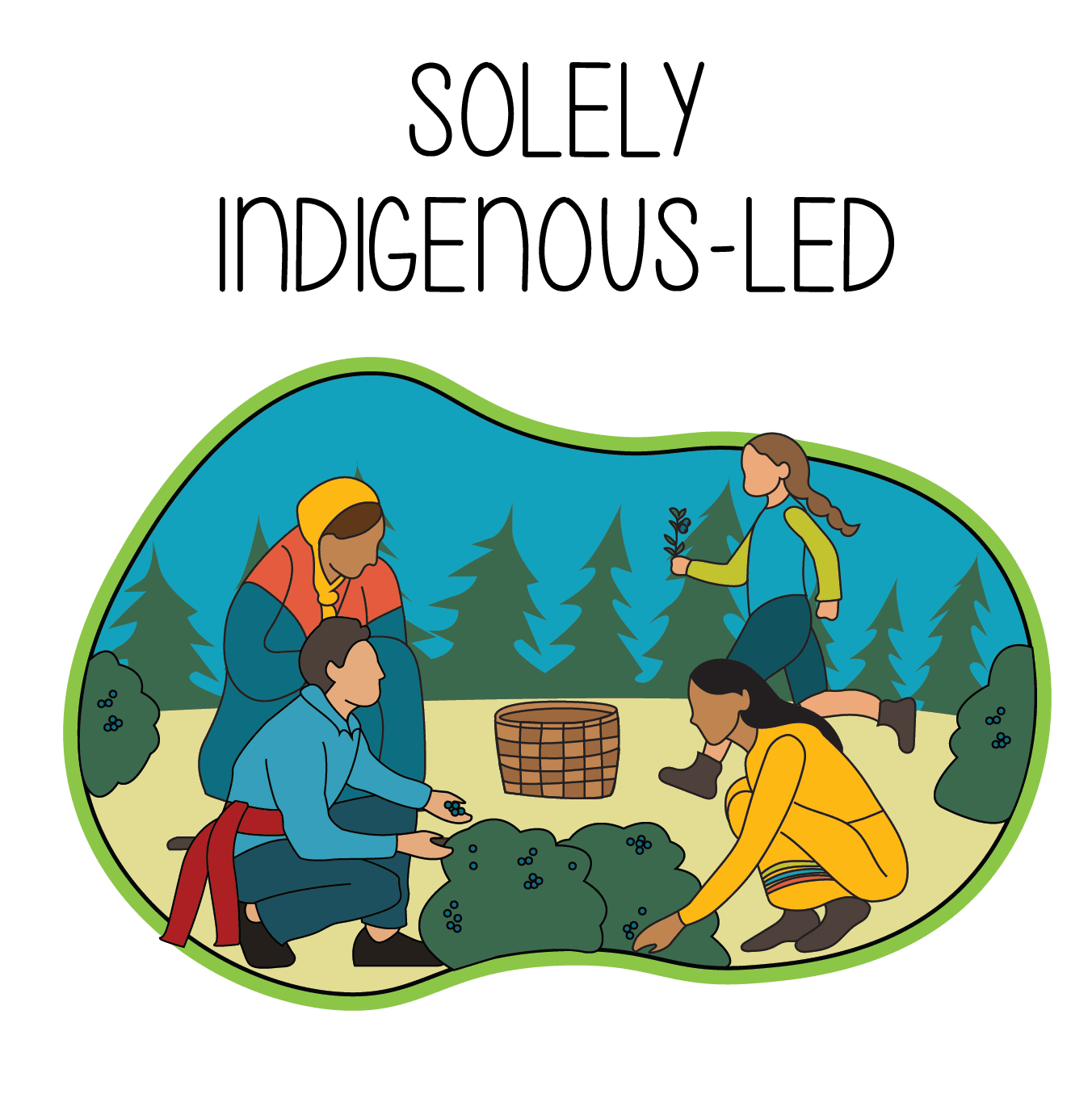
Dasiqox-Nexwagwez?an
Snapshot
Lead Governments: Xeni Gwet’in First Nation and Yuneŝit’in Government with the support of the Tsilhqot’in National Government
Read more about the Dasiqox-Nexwagwez?an communities and government in the Additional Context Section.
Governance model: Solely Indigenous-led (Co-governed by Xeni Gwet’in First Nation and Yunesit’in Government)
Established: Announced in October 2014.
Read more about Dasiqox-Nexwagwez?an in the Establishment Section.
Location: Tsilhqot’in territory (southern interior of B.C.) about 125 km southwest of Williams Lake
Approximate size: 3,200km2
Dasiqox-Nexwagwez?an was designed to connect to other protected areas (e.g., B.C. Parks, Tsilhqot’in Title Lands, etc.). Including Dasiqox-Nexwagwez?an, the overall area is 9,418km2.
Quick Facts:
- The leadership of Xeni Gwet’in First Nation and Yunesit’in Government jointly governs the area with the support of a technical team and with community input.
- Plans are underway to create an Advisory Board and a Working Group.
- Protects the Dasiqox watershed, including mountains, rivers, lakes, forests, culturally and ecologically important places, plants and wildlife.
- Includes areas untouched by industrial development and areas heavily impacted by forestry.
- Does not include, but is adjacent to, Tsilhqot’in title lands.
- Potential mining development and ongoing logging threatens the area.
Vision Statement and Principles:
The vision for Dasiqox-Nexwagwez?an reflects the priorities, values, and input from extensive engagement with Tsilhqot’in communities over several years. Dasiqox-Nexwagwez?an has four main goals:
- Ecological protection;
- Cultural revitalization;
- Sustainable livelihoods; and
- Health and healing.
See the Nexwagwez?an Community Vision and Management Goals (PDF)
Vision and Principles
“With the Dasiqox Tribal Park, the Tsilhqot’in people assert our responsibility and our right to protect this place where the waters, land, forests, animals, and people are full of life, thriving, healthy, and strong in our relationships with each other.
We are part of the land; the land is part of us. We take care of each other. Our spirits are joined with this place, through time.
The Dasiqox Tribal Park is the heart of a strong Tsilhqot’in culture. It is a place where we hunt, fish, learn, teach, and share while spending time out on the land respectfully, a place where we feel happy and healthy.
It is there for us; it is there for future generations. Nexwagweẑʔan.”
Source: Nexwagweẑʔan: Community Vision and Management Goals for Dasiqox Tribal Park (PDF)
Website: https://dasiqox.org/
Map:
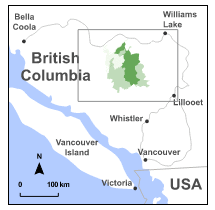
A map of Dasiqox Tribal Park Initiative 2020. (Source: Dasiqox-Nexwagwez?an website)
Video: Gagulhchugh Nen Gagusun (The land looks good all around).
Governance Details
Who makes decisions?
Leadership
Currently, the Chief of Xeni Gwet’in and the Chief of Yunesit’in (or their appointed Councillors), or “leadership,” make decisions about Dasiqox-Nexwagwez?an. The Chiefs and Councillors of Xeni Gwet’in are elected for a five-year renewable term. While the leadership for Yunesit’in are elected for a four-year renewable term and elections are staggered every two years.
Dasiqox-Nexwagwezʔan is within the Shared Caretaker Area of the Xeni Gwet’in and Yunesit’in. This is an area for which both communities have traditionally shared responsibility and use. Xeni Gwet’in and Yunesit’in signed a Shared Caretaker Agreement, called the “Yunesit’in and Xeni Gwet’in Shared Territorial Caretaker Protocol Agreement” (currently not a public document) as the basis for co-governing Dasiqox-Nexwagwez?an. This agreement outlines the commitment and decision process by which both communities work together cooperatively to govern and manage the shared area. The agreement is the basis for Dasiqox-Nexwagwez?an’s joint Indigenous decision-making model.
According to Russell Myers Ross (Yunesit’in), Governance Advisor for Dasiqox-Nexwagwez?an:
“This agreement binds us in some form of unity, so if something is going to happen on our land, we can both deal with it together. That was the foundation, that thread of unity.”
Technical Team
A technical team supports leadership with decision-making. This small team of core members has varied between one and four members. The core team maintains long-term institutional knowledge of the initiative through leadership changes.
Technical team positions are formally listed as follows, though in practice roles and responsibilities cross all portfolios and are shared as necessary to get the work done:
● Community Coordinator;
● Team Coordinator;
● Governance Advisor; and
● Stewardship and Management Planner
Advising and taking direction from leadership, the technical team advances Dasiqox-Nexwagwez?an and carries out day-to-day operations. The technical team is involved in:
● Programming (cultural, youth, language, stewardship, employment, training);
● Communications;
● Community engagement;
● Political negotiations and strategy;
● Stewardship, monitoring, and restoration;
● Management planning, implementation, and operations;
● Liaising and collaborating with related Tsilhqot’in government initiatives, staff, and contractors;
● Research and partnerships;
● Administration;
● Fundraising and donor relations; and
● Reporting.
Advisory Board and Working Group
The Dasiqox-Nexwagwez?an Initiative is in the process of creating an Advisory Board and a Working Group. Each body will have a distinct role, though neither will hold final decision-making power.
The Advisory Board will consider governance, legal, political and applied aspects of Dasiqox-Nexwagwez?an, and will advise leadership, making recommendations on relevant strategic and legal negotiations. The Advisory Group will be composed of a majority of Tsilhqot’in members, as well as key legal and technical staff or contractors.
The Working Group will be a task-oriented group responsible for advancing, reviewing, and supporting the completion of the management plan and related projects. The Working Group will be composed of community members from Xeni Gwet’in and Yunesit’in and will be supported and facilitated by members of the Dasiqox-Nexwagwez?an core technical team.
These bodies will support consistency in decision-making and engage diverse community members in operations of the IPCA, while relieving some pressures on elected leadership.
How are decisions made?
Leadership from the two communities make consensus-based decisions. The technical team supports decision-making by providing information, briefings, options, technical advice, and making recommendations as appropriate. The technical team also helps to inform and support leadership decisions by liaising with community members, Indigenous government staff, contractors, academics, researchers, and non-governmental organization (NGO) partners, and bringing their collective experience to discussions at the decision-making table.
According to Russell Myers Ross (Yunesit’in), Governance Advisor for Dasiqox-Nexwagwezʔan:
“…the governance [of Dasiqox-Nexwagwezʔan] is meant to ensure stability as it ensures both communities are part of the decision-making and seek the best advice from technical personnel and values expressed by the community. The ability to respond to advice, diversity, and new ideas of innovation is the place that we want to be to create legitimacy.”
Diagram: The planned decision-making process for the Dasiqox-Nexwagwez?an Initiative.
When formed, the recommendations of the Advisory Board will be made by consensus and presented to leadership. Since the process is underway, details are being worked out.
The Shared Caretaker Agreement between Xeni Gwet’in and Yunesit’in outlines a dispute resolution process that can be used.
Governance Meetings
The leadership and technical team meet quarterly to review progress, discuss strategy, programming and opportunities, delegate work, allocate resources, and make decisions.
Members of the technical team meet monthly or more often as needed to advance projects and work between the governance meetings.
Management Plan
The technical team, working under the direction of leadership, are engaged in an ongoing management planning process for Dasiqox-Nexwagwez?an. This process has been developed from within the Dasiqox team. The planning process draws on Tsilhqot’in customs, governance strategies, planning, and facilitation techniques for community engagement. Leadership and the technical team are in the process of finalizing the plan after receiving extensive community input.
The management plan includes reports, community engagement materials, operational guidelines for specific sectors and activities, work plans, and guidelines or standards, among other outputs.
The plan has two audiences:
- Internal: A guide for leadership, decision-making, management and operations; and
- External: A guide for other governments, industry, visitors, and people engaging in activities in Dasiqox-Nexwagwez?an.
Key components of the plan include:
- The context, story, and purpose of Dasiqox-Nexwagwez?an;
- Foundational principles and values, rooted in Tsilhqot’in law;
- Governance and management roles and responsibilities;
- Goals, objectives, strategies, targets, and actions;
- Management areas, zones, and/or designated activities; and
- A framework for ongoing monitoring and evaluation.
Since 2016, the technical team has engaged community members in many ways, including:
- Workshops;
- Land-based gatherings;
- Interviews, focus groups;
- Open houses; and
- Family meetings for community members.
The Dasiqox-Nexwagwez?an team documented, reviewed, edited, and translated community input with consent from participants.
Tsilhqot’in leaders and knowledge holders reviewed drafts of the management plan. This ensures that the priorities and values of community members and Elders are included in the plan.
The management planning process is a strong and collaborative model. The Tsilhqot’in National Government has adopted the model in land use planning. Other IPCAs across Canada have also followed this example. The Technical Team has shared this model with other communities, First Nations, and government representatives through meetings and presentations.
Read more about management planning and community engagement for Dasiqox-Nexwagwez?an in the Additional Context Section.
Who are decision-makers accountable to?
Decision-makers are accountable to Xeni Gwet’in and Yunesit’in Elders and community members, as well as to nenqay (the lands, waters, animals, plants, spirits and place as a whole). The leadership of Xeni Gwet’in and Yunesit’in are accountable to each other, and to the communities, as outlined in the Shared Caretaker Agreement.
Laws and Legislation
The Dasiqox-Nexwagwez?an Initiative is striving for Tsilhqot’in laws to inform the management and operations of Dasiqox-Nexwagwez?an. Dasiqox-Nexwagwez?an is an expression of Tsilhqot’in responsibilities to the lands and waters which are upheld by Tsilhqot’in law. Many Xeni Gwet’in and Yunesit’in members—especially Elders—practice Tsilhqot’in law.
The technical team is conducting interviews with Elders to gather information about traditional Tsilhqot’in law.
Dasiqox-Nexwagwez?an Initiative is not seeking protection under provincial (B.C.) or federal (Canada) legislation at this time. However, the communities do have intentions to negotiate with the Crown. It was important to ensure that the Management Plan was designed based on the vision and plans of the communities before negotiations were pursued.
Dasiqox-Nexwagwez?an is protected solely under Tsilhqot’in law. This means that Dasiqox-Nexwagwez?an is vulnerable to unwanted mining development and logging by external companies.
Read more about the Tsilhqot’in 30-year struggle to prevent the construction and operation of a proposed mine in the Establishment Section.
Advantages and Challenges of Governance Model
The summary below is based on the current governance structure. Decisions are currently made by the leadership of both communities, with the support of a technical team.
Advantages
- An agile structure that supports flexibility, experimentation, and quick action.
- The vision, principles, and management planning express community input and Tsilhqot’in values and priorities.
- Technical staff can reduce burden on leaders.
- The Shared Caretaker Agreement supports a joint Indigenous co-governance model in shared territories.
- A good working relationship exists among leaders and between leaders and staff.
Challenges
- Capacity and availability of elected leadership is limited.
- The turnover of elected leaders affects consistency and institutional knowledge.
- A lack of Crown legislation to protect Dasiqox-Nexwagwez?an leaves it vulnerable to resource extraction.
Further Reading
Multimedia
- Dasiqox Tribal Park Resources
- Dasiqox-Nexwagwezʔan Videos
- Dasiqox-Nexwagwez?an Community Vision and Management Goals
- The Conversation (2019): Tsilhqot’in blockade points to failures of justice impeding reconciliation in Canada
- The Narwhal (2015-2019): Feature Stories on Dasiqox-Nexwagwez?an
Academic
- Youdelis, M., Townsend, J., Bhattacharya, J., Moola, F., & Fobister, J. B. (2021). Decolonial conservation: Establishing Indigenous Protected Areas for future generations in the face of extractive capitalism. Journal of Political Ecology.
- Bhattacharyya, J., & Slocombe, S. (2017). Animal agency: Wildlife management from a kincentric perspective. Ecosphere, 8(10), e01978.
Establishment
Protecting the Land for Future Generations
As the Dasiqox-Nexwagwez?an Initiative explains, “We are developing an alternative vision for the management and governance of the land in this area that reflects the values of our people, who live from the land.”
With the guidance of Elders and community input, Xeni Gwet’in and Yunesit’in announced Dasiqox-Nexwagwez?an in October 2014. Dasiqox-Nexwagwez?an focuses its efforts on environmental protection, cultural revitalization, sustainable livelihoods, and health and healing.
More recently the Dasiqox-Nexwagwez?an Initiative dropped the words “Tribal Park” from the name. Although Tribal Park was initially suggested by Elders, the word “park” raises concerns for some community members. They worry that if it is a park, then they will not be able to hunt, trap, or access those areas, which is not the case.
The Tsilhqot’in word “Nexwagwez?an,” which translates to “there for us,” better reflects the intent of the IPCA.
The communities did not want to pursue Crown protected areas (like provincial parks and conservancies) because they would have had less say over what happens in these areas.
Diagram: A timeline of events leading to the establishment of Dasiqox-Nexwagwez?an. (Originally published in Youdelis, M. & Townsend, J. & Bhattacharyya, J. & Moola, F. & Fobister, J., (2021) “Decolonial conservation: establishing Indigenous Protected Areas for future generations in the face of extractive capitalism”, Journal of Political Ecology 28(1). doi: https://doi.org/10.2458/jpe.4716)
Why establish Dasiqox-Nexwagwez?an?
Two of the main reasons why the communities announced Dasiqox-Nexwagwez?an were because of an important court decision and to protect the area from resource extraction.
2014 Tsilhqot’in Decision
In September 2014, the Supreme Court of Canada recognized Tsilhqot’in title over approximately 1800km2 of their title claim area in the southern interior of B.C. This case was the first (and so far, only) time Canada recognized the existence of “Aboriginal title.” This means that Tsilhqot’in communities will have more authority to make decisions about what happens in title lands.
However, the Supreme Court of Canada did not recognize Tsilhqot’in title over all of Tsilhqot’in territory. According to Russell Myers Ross, Governance Advisor for Dasiqox-Nexwagwez?an:
“We couldn’t be fazed by the fact that there is a declaration and it didn’t include certain parts [of our territory]. We said this whole place is significant to us. It’s still sacred to us. We still think this whole area is significant to our survival and to our culture, we’re not going to abandon this area. We still have to honour our responsibilities; we still have to honour our stories that reside there and the animals that live there.
Dasiqox-Nexwagwez?an is at the head waters of Tsilhqot’in Nation, where we need to be very sensitive as water runs downhill. B.C. and Canadian history has shown large impacts to our lands, water, resources, and Aboriginal Title & Rights.”
Conflicts over resource extraction
While the Supreme Court of Canada decision was cause for celebration, there was also a problem. A major open-pit gold and copper mine was proposed in part of Tsilhqot’in territory where title was not recognized. This area included two especially sacred places for Tsilhqot’in peoples: Teztan Biny (a lake) and Nabas (surrounding area). The Dasiqox headwaters, river, and watershed are also in this area and are all ecologically and culturally significant.
The Canadian Environmental Assessment Agency would not allow the project to go ahead, but the British Columbia Environmental Assessment Office approved the project. The federal assessment agency found that if the project was built, it would have major environmental impacts and cultural impacts on the Tsilhqot’in.
The Tsilhqot’in fought this mining proposal for about 30 years. A standstill agreement was reached in 2020, and finally, in 2021 the project appears to have been dropped. However, there is still a risk that a new mining project could be proposed before the mineral leases expire.
Additional Context
Communities and Government
Xeni Gwet’in and Yunesit’in are two of six Tsilhqot’in communities (or First Nations). Each community has its own elected Chief and Council. The Xeni Gwet’in First Nation has 455 registered members and the Yunesit’in Government has 493 registered members. About half of the members live on reserve.
The six Tsilhqot’in communities are members of the Tsilhqot’in National Government (TNG). TNG’s mission is to “empower Tŝilhqot’in peoples to exercise, effectively and appropriately, their rights to self-determination in their traditional territories in ways which reflect Tŝilhqot’in philosophy, values, experience, and culture.” TNG includes leadership from each community and is involved in negotiations with B.C. and Canada.
Community Engagement
Since 2015, the Dasiqox-Nexwagwez?an Initiative has engaged Tsilhqot’in members, and neighbouring communities by hosting, participating in, and producing:
- On the land gatherings;
- Community meetings and dinners;
- Monthly general assemblies;
- Open houses, focus groups, and interviews;
- Informal discussions and formal presentations at community events;
- Culture and language camps on the land;
- Social media, a web page, and videos; and
- Newsletters, pamphlets, and posters.
For more information, see these resources:
- 2018-2019 DTP Public Engagement Summary Report (June 2019)
- Summary: Community Vision & Management Goals for Dasiqox Tribal Park (April 2018)
Alliances and Partnerships
The IPCA was declared with the support of Friends of the Nemaiah Valley, a volunteer not-for-profit society composed of allies who have helped fight against unwanted development in the territory. Friends of the Nemiah Valley fundraised to commission reports and studies on Indigenous protected areas and what opportunities these might offer Xeni Gwet’in and Yunesit’in.
They also managed research, established funding partnerships, and managed administration and funding in the early years before passing everything directly to the First Nations.
Dasiqox-Nexwagwezʔan is currently administered on the MakeWay Foundation Shared Platform. With direction from Dasiqox leadership and Coordinators, MakeWay provides administrative support and manages the IPCA’s accounting. The IPCA’s primary funding comes from the Wilburforce Foundation, with additional support from other organizations.
The IPCA has benefited from collaborations with researchers and academics, including through the Core Technical Team members’ relationships with the University of Victoria and The University of British Columbia, as well as the Conservation through Reconciliation Partnership. Dasiqox-Nexwagwezʔan has been featured in multiple academic articles, chapters, theses, op-eds, and newspaper articles.
The Tsilhqot’in have also been developing relationships with local non-Indigenous residents for decades, which has helped to facilitate understanding and support for Dasiqox Nexwagwezʔan. According to Dr. Roger William, Team Coordinator and Community Outreach for Dasiqox Nexwagwez?an:
“There’s a lot of relationship history with tenure holders and private landowners. There’s been communications and meetings, or as people just meeting in coffee shops or through schools. There’s that history there, and that gives us an idea of what their issues are.
And some of them share similar concerns with government and the impact of development with us. That history is there, some of it is good, some of it is bad. But navigating and communicating and understanding is really, really important to what we’re trying to do.”
Indigenous Guardians Program
There is a desire to fund and build out an Indigenous Guardians Program as part of the IPCA’s long-term plan.
The Tsilhqot’in have developed a Title Land Ranger program which includes 12 trained rangers from four Tsilhqot’in communities. The Rangers monitor and care for the entire Declared Title Area recognized by the Supreme Court. Dasiqox is directly adjacent to this area.
How do Tsilhqot’in Peoples Exercise Rights and Responsibilities?
Dasiqox-Nexwagwezʔan is an assertion of Tsilhqot’in rights and responsibilities to their entire territory. The Tsilhqot’in exercise their rights to practice their livelihoods in the whole territory, and to protect the lands and waters from unwanted development.
According to Dasiqox-Nexwagwezʔan Governance Advisor, Russell Myers Ross:
“I think for those that want to begin the process [of establishing an IPCA], it’s important to have a committed, unifying cause, with mutual values as a place to start. If I were to distill a few important pieces that have worked, I would look at the leadership that cares deeply about the area, willing and eager to work as a team for a common cause and to speak in a unifying way.

Qat’muk
Snapshot
Lead Government: Ktunaxa First Nation
Governance Model: Solely Indigenous-led. (This may evolve as the governance details are worked out).
Established: Declared in 2010 by Ktunaxa Nation who decided to pursue an IPCA in 2018. (The IPCA is not yet established).
Read more in the Establishment Section.
Location: Southeast B.C.
Approximate Size: 700+ km2
Quick Facts:
- The decision to pursue an IPCA ended a more than 30-year effort to protect the territory from the proposed Jumbo Glacier Mountain Resort by Glacier Resorts Limited.
- The IPCA will protect Kⱡawⱡa Tukⱡuⱡakʔis (Grizzly Bear Spirit), the homelands of the Ktunaxa, grizzly bears and their critical habitat, and ʔakxamis q̓api qapsin (All Living Things).
- Work on the IPCA is guided by Cultural and Spiritual Interpreters, Leadership, and Ktunaxa of all ages.
Qat’muk Declaration Statement:
“We, the Ktunaxa, have lived in our territory since time immemorial and have a deep spiritual connection to the animal world and, in particular, to the grizzly bear.
Qat’muk is a very special place where Kⱡawⱡa Tukⱡuⱡakʔis, the Grizzly Bear Spirit, was born, goes to heal itself, and returns to the spirit world.
The Grizzly Bear Spirit is an important source of guidance, strength, protection and spirituality for the Ktunaxa. Qat’muk’s importance for the Grizzly Bear Spirit is inextricably interlinked with its importance for living grizzly bears now and in the future. The Ktunaxa have a stewardship obligation and duty to the Grizzly Bear Spirit and Qat’muk.”
Read more about the vision and proclamation of Qat’muk here.
Website: https://www.ktunaxa.org/qatmuk/
Map:
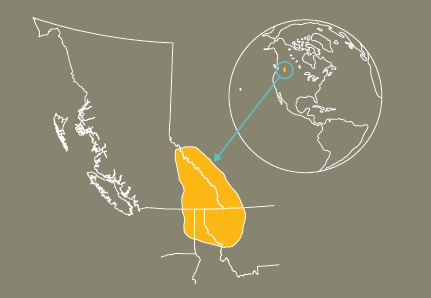
A map of Ktunaxa Territory, Qat’muk. Source: Ktunaxa Nation
Governance Details
Who makes decisions?
The governance model for the Qat’muk IPCA is currently under development.
The decision to pursue an IPCA for Qat’muk was made by the Ktunaxa Nation Executive Council with advice and guidance from the Qat’muk Advisory Committee.
The Qat’muk Advisory Committee was established prior to 2010 and included Elders, Cultural and Spiritual Interpreters, and knowledge holders who guided the development of the Qat’muk Declaration. The Advisory Committee provided advice and guidance on the legal and overall approach to defend Qat’muk.
The Qat’muk Declaration was approved by the Ktunaxa Nation Executive Council and presented to the B.C. legislature in 2010 by a delegation of Ktunaxa. Following a loss at the Supreme Court of Canada in 2017, the Ktunaxa Nation Executive Council decided to pursue the establishment of an IPCA and in 2019, federal funding was secured through the Canada Nature Fund.
Since that time, Ktunaxa Nation Executive Council staff members have been working with the Qat’muk Cultural and Spiritual Interpreters (which includes the Qat’muk Advisory Committee) and conducted extensive citizen and leadership engagement to develop the “Ktunaxa Nation Statement for the establishment of the Qat’muk Indigenous Protected and Conserved Area (IPCA).”
This Statement is a critical step in this process as it outlines the Vision and Principles that will guide the establishment of the Qat’muk IPCA.
This Statement will be presented to the Province of B.C. and Environment and Climate Change Canada. Once the Statement has been presented to the Province of B.C., the team will determine the IPCA’s long-term governance structure. Cultural and Spiritual Interpreters, Elders, and knowledge holders will continue to play a key role in the governance of Qat’muk
Community Engagement
The Qat’muk IPCA team has extensively engaged with the Cultural and Spiritual Interpreters, Ktunaxa citizens, leadership, and youth for the past several years (2019-2022). Much of their engagement began online due to the COVID-19 pandemic which worked surprisingly well.
Elders, knowledge holders, and youth were all able to adapt to the new world of virtual meetings and engage with a broader and more diverse group of community members compared to in-person meetings.
Once pandemic restrictions lifted, extensive in person engagement continued, ranging from community meetings and house to house visits, to on-the-land camps and gatherings.
This meaningful engagement ensured that Ktunaxa values and worldview are within the foundation of the Statement, and particularly within the Vision and Principles.
How are decisions made?
The decision-making model is currently being worked out. Decisions will continue to be guided by Cultural and Spiritual Interpreters, Ktunaxa elected leadership, and Ktunaxa citizens with support from Qat’muk IPCA staff.
Laws and Legislation
Ktunaxa Law
The Qat’muk Declaration was delivered by a large delegation of Ktunaxa to the B.C. Legislature in 2010. The Declaration itself is a proclamation of Qat’muk as a sacred place to the Ktunaxa because of Kⱡawⱡa Tukⱡuⱡakʔis.
The Declaration outlines the refuge and buffer area of Qat’muk, Qat’muk Stewardship Principles, and Special Requirements for Qat’muk. It is the foundation of all the work that the Ktunaxa are now engaging in to establish an IPCA.
Within the Declaration, Ktunaxa Law ʔaknumuȼtiⱡiⱡ is shared:
“ʔaknumuȼtiⱡiⱡ is our word for the law given to the Ktunaxa by the Creator. It is a powerful word and speaks to why we were put on this land. We were born into this land and someday we will return through death. The Creator put us here for a reason and that purpose is to take care of the land and its resources.
The law of the land, ʔaknumuȼtiⱡiⱡ, is the law for survival. The law protects the values inherent in the land. The land gives us the resources to survive, and in return, we uphold our covenant with the Creator to protect and not overuse the land.
The law is grounded in the fact that all things are connected and must be kept in balance. It is also the foundation of our spirituality – that of being humble in our limited understanding and of being respectful of our role within nature and with other creatures, as well as being respectful and acknowledging the Creator and our ancestors.” (Qat’muk Declaration, 2015)
Crown Law
The Province of B.C. designated an area within Qat’muk under a Section 16 of the Land Act. This designation does not allow any Land Act tenures within a portion of the proposed IPCA.
Who are decision-makers accountable to?
The IPCA Team is accountable to the Cultural and Spiritual Interpreters, Ktunaxa citizens, and elected Leadership. Elders and knowledge holders guide decision-making through the Qat’muk Cultural and Spiritual Interpreters. The development of the Declaration has been a community-driven process.
Management Plan
The Ktunaxa phrase hu yaqaniⱡ hankatiⱡmumaⱡnaⱡa·ki na ʔamak, meaning “our people care for the land, the land cares for our people” reflects the interconnectedness of all things and forms the basis of Ktunaxa’s land stewardship philosophy. This philosophy gives rise to the following stewardship principles, which will guide the development of a stewardship plan:
- Contribute to the betterment of future generations;
- Balance the economic use of land with cultural spiritual values;
- Follow natural law of taking only what is needed;
- Ensure that long-term sustainability and ecological integrity take precedence;
- Ensure access to, and protection of, traditional foods, medicines, resources, and spiritual sites;
- Maintain, protect, manage, and restore healthy and diverse ecosystems; and
- Ensure land, air, and water are, and will be, clean and healthy.
The Declaration outlines a refuge area, including the upper part of the Jumbo Valley, and a buffer area, including the remainder of the Jumbo watershed. Both of these areas will be shared with non-Ktunaxa citizens, given that Ktunaxa spiritual values and stewardship principles are respected.
The construction of buildings or structures with permanent foundations, the occupation of residences, or any other activity that harms the spiritual nature of the area will not be permitted in either zone.
The establishment of the Qat’muk IPCA will use the Declaration as a foundational guide. The Ktunaxa will invite other governments and stakeholders to participate in the development of a stewardship plan for the Qat’muk IPCA, which will include (but not be limited to) the refuge and buffer area identified in the Qat’muk Declaration.
Advantages and Challenges of Governance Model
Long-term governance and decision-making details are still being worked out for Qat’muk. Below are advantages and challenges of the approach for the Qat’muk IPCA process so far:
Advantages
- The extensive engagement with Cultural and Spiritual Interpreters, Ktunaxa communities, and leadership has led to broad support and buy-in from Ktunaxa.
- The community engagement process, along with guidance from Cultural and Spiritual Interpreters, has led to the creation of the Ktunaxa Nation Statement for the Establishment of the Qat’muk IPCA.
- This Ktunaxa-driven process is a strong foundation and approach for moving forward on the creation of the IPCA.
Challenges
- Work remains for the development of a long-term governance model for Qat’muk.
- The pressures, habits, and bureaucracy of colonial systems will continually challenge this work. (For example: requiring a Terms of Reference or other western bureaucratic tools, the approach and process for stewardship planning, and timelines).
- The COVID-19 pandemic made community engagement difficult, although it also allowed for new and creative ways of engaging. While virtual engagement was not preferred or as effective, it proved to be efficient.
Advice
According to Kerri Garner, Land Stewardship Planner, Strategic Initiatives Policy & Planning, Ktunaxa Government:
“I think that the internal work is the most important by far. You need to spend the time with your citizens, your communities, and your knowledge holders and make sure that you have your vision and your principles, what you’re trying to achieve, and that everybody is on the same page. That is super critical.
As well, do not let the province or the feds dictate what is not their business. This is Indigenous-led, which means they need to respect that, and hold them to that. And just expect the unexpected, because these things take so much longer than you expect.”
Further Reading
- The Narwhal (2014): Ktunaxa Chief Willing to Go to Jail to Stop Jumbo Glacier Resort In Sacred Spiritual Place Qat’muk.
- The Narwhal (2014): Jumbo Glacier Ski Resort Threatens Grizzlies in Southern B.C., Into U.S.: Scientists.
- WYSS Campaign for Nature (2020): Ktunaxa Nation Council Celebrates Decades Long Battle to Safeguard Qat’muk, Keep Jumbo Wild.
Establishment
The Ktunaxa Nation delivered the Qat’muk Declaration to the B.C. Legislature in 2010. After more than 30 years fighting to protect Qat’muk from the proposed Jumbo Glacier Mountain Ski Resort, a decision was made to pursue the Qat’muk IPCA.
To achieve this, the Ktunaxa Nation was successful in their application to the Canada Nature Fund and was awarded $16.2 million to establish Qat’muk as an IPCA.
With assistance from the Nature Conservancy of Canada and an additional $5 million pledged by several donors (see list below in the Additional Context section), the Ktunaxa were able to extinguish Glacier Resorts Limited’s development rights for a year-round ski resort and Master Development Plan in the Jumbo Valley.
Qat’muk is a sacred place where the Kⱡawⱡa Tukⱡuⱡakʔis, the Grizzly Bear Spirit, was born, heals itself, and returns to the spirit world. As the Grizzly Bear Spirit is a vital source of protection and guidance for the Ktunaxa, the Nation has a stewardship obligation to protect Qat’muk and the grizzly bears that inhabit it.
See a timeline of Qat’muk establishment at the following link: https://www.ktunaxa.org/qatmuk/
Additional Context
Alliances and Partnerships
Qat’muk receives logistical support from the Nature Conservancy of Canada (NCC), and financial support from the Wyss Foundation, Wilburforce Foundation, Patagonia, the Columbia Basin Trust, and Donner Canadian Foundation.
The NCC helped to develop the ecological rationale for protection, which was needed to secure federal funding for Qat’muk. NCC also acted as the negotiator with Glacier Resorts on behalf of the Ktunaxa, leading to the cancellation of the project.
NCC is now assisting with ongoing conservation planning.
Indigenous Guardian Program
The Ktunaxa have developed their own Guardian Program called the ʔa·knusti Program. ʔa·knusti will play a major role in the long-term stewardship of Qat’muk as well as all of Ktunaxa ɁamakɁis. The full details of this role are currently being worked out.

Indigenous – Crown

Thaidene Nëné
Snapshot
Lead Government: Łutsël K’é Dene First Nation (LKDFN)
Governance Model: Indigenous-Crown Partnership
Established: Declared by LKDFN in 2000, established in 2019.
Read more about establishment in the Establishment Section.
Location: In eastern Northwest Territories (western edge of Thaidene Nëné is about 100km east of Yellowknife), includes the East Arm of Tu Nedhé (Great Slave Lake).
Approximate Size: 26,376 km2
Quick Facts:
- Indigenous-led with certain aspects of governance shared with Parks Canada and the Government of the Northwest Territories (GNWT).
- Guided by the all-Indigenous Thaidene Nëné Xá Dá Yáłtı who make decisions by consensus.
- Provides habitat for bears, wolves, moose, muskox, and caribou.
- Connects youth to the land through the Ni Hat’ni Dene.
Vision Statement:
“Thaidene Nëné is the homeland of the people whose ancestors here laid down the sacred, ethical and practical foundations of their way of life. This land has nurtured and inspired countless generations whose prosperity continues to be ensured by a deep intimacy between the people and the land. For the well-being of future generations, this way of life needs to be exercised, nurtured, and passed on.
The living connection between land and people, between water and land, between forest and barrens makes Thaidene Nëné a National Treasure of Canada. Carrying these relationships into the future, the ecological integrity and Dene way of life of Thaidene Nëné will be a living legacy for all, where the Łutsël K’é Dene First Nation and the Parks Canada Agency/GNWT will welcome the world.” (Thaidene Nëné: Establishment Agreement Summary)
Website: http://www.landoftheancestors.ca/
See the Thaidene Nëné Story for more information.
Map:
A map of Thaidene Nëné, located in the Northwest Territories, on the East Arm of Tu Nedhé (Great Slave Lake). Source: Thaidene Nëné Establishment Agreements Summary
Governance Details
Who makes decisions?
Thaidene Nëné Xá Dá Yáłtı
The Thaidene Nëné Xá Dá Yáłtı, or “the people who speak for Thaidene Nëné,” guide the operations and governance of Thaidene Nëné. The Thaidene Nëné Xá Dá Yáłtı advises the parties (LKDFN, GNWT, and Parks Canada) on subjects such as cultural protection and rejuvenation, ecological protection, access and use permits, budgets and expenditures, and research and monitoring.
The parties then work together to implement the board’s recommendations, sharing responsibility for operations. According to the Thaidene Nëné website, “The parties work together to determine, for example, who will build a boardwalk or who will staff a safety patrol.”
How are decision-makers determined?
Each party appoints individuals to Xá Dá Yáłtı who, upon appointment, no longer represent the parties that appointed them but speak only for Thaidene Nëné. The LKDFN appointees participate in all decisions for all of Thaidene Nëné. The Parks Canada and GNWT appointees only participate in decisions relevant to the National Park Reserve or territorial protected areas respectively.
A detailed account of how Thaidene Nëné Xá Dá Yáłtı are determined can be found in the establishment agreement between LKDFN and GNWT.
Diagram: The composition of Thaidene Nëné Xá Dá Yáłtı, or “the people who speak for Thaidene Nëné”. Source: landoftheancestors.ca
Who are decision-makers accountable to?
The Thaidene Nëné Xá Dá Yáłtı was established with the guidance of LKDFN Elders and the Thaidene Nëné Advisory Committee. The LKDFN appointees are accountable to the Elders and community members, and all parties are accountable to one another. Parks Canada and the GNWT are responsible for upholding the treaty of 1900 and LKDFN rights enshrined in Section 35 of the Canadian Constitution.
How are decisions made?
The Thaidene Nëné Xá Dá Yáłtı uses consensus-based decision-making to make recommendations to the parties. Once the parties accept the recommendations, they become official decisions.
If any of the parties disagree with a recommendation, the issue is moved through a consensus process. If the dispute is not resolved through mediation, the issue is referred to the LKDFN Chief and the relevant Minister. The dispute resolution process is similarly detailed in the establishment agreement.
The Thaidene Nëné Xá Dá Yáłtı uses a Two-Eyed Seeing approach to decision-making, based on local Indigenous knowledge and western science, with equal respect and weight given to all knowledge systems.
Diagram: A diagram of the Thaidene Nëné decision-making process. Decisions about Thaidene Nëné are made by consensus between the territorial government, Parks Canada, and the Łutsël K’é Dene First Nation. In cases where consensus cannot be reached through mediation, the issue goes to the LKDFN Chief and the appropriate Minister.
Laws and Legislation
Thaidene Nëné was established by the LKDFN, the GNWT and Parks Canada under three legal orders and four protected area designations. The IPCA is Indigenous-led, with certain aspects of governance shared with Crown government partners.
LKDFN Law
The entirety of Thaidene Nëné is designated under Łutsël K’é Dene law. There are three central LKDFN laws that govern the IPCA. The first law was put down in the time of early creation – the time of the giant animals. It commands LKDFN to protect the area around Ts’ąkuı Theda:
“As long as Ts’ąkuı Theda is respected and the area around her is respected, she will be there for us, for all people, not just Łutsël K’é Dene. Ts’ąkuı Theda is the heart of Thaidene Nëné, everything flows out from her. The Thaidene Nëné Indigenous Protected Area protects her ecosystem and her watershed.” (Thaidene Nëné: Ts’ąkuı Theda)
The second law determines the boundary of Thaidene Nëné. In 2002, the Elders drew a map highlighting the area they wanted to protect, which was ratified by the community in 2004.
After ensuring that all members of LKDFN understood the establishment agreements, the membership voted to support the agreements with 88 percent approval in 2018, which became the third law used to establish the IPCA.
Provincial and Federal Law
Thaidene Nëné is also protected under Crown laws in three ways:
- 14,305 km2 of Thaidene Nëné is designated under the federal National Parks Act as a national park reserve;
- 3,165 km2 is designated under the Northwest Territories (NWT) Wildlife Act as a wilderness conservation area; and
- 8,906 km2 is designated under the NWT Protected Areas Act as a territorial protected area.
The NWT Protected Areas Act (2019) was developed collaboratively with Indigenous governments and requires the GNWT to work with Indigenous governments throughout every phase of territorial protected area development. Under this new act, the GNWT must negotiate establishment agreements with local Indigenous governments for any proposed protected area.
The territorial protected area in Thaidene Nëné was the first to be protected under this new legislation. LKDFN negotiated establishment agreements with both GNWT and Parks Canada for Thaidene Nëné where LKDFN would be the primary and consistent governing entity throughout the entire territory. The territorial establishment agreement is publicly available and LKDFN have published an Establishment Agreements Summary.
Relation to Treaty of 1900 (Treaty 8)
The establishment agreements are legal contracts and not a land claim or modern treaty. The question of who owns the land is not resolved in the agreements. The LKDFN maintain their rights to practice their way of life in Thaidene Nëné.
Since 1992, the Akaitcho Dene First Nations have been negotiating a land, resources, and governance agreement that will update the Treaty of 1900 (Treaty 8). Thaidene Nëné can be understood as a mechanism for implementing the Treaty of 1900, which was meant to guarantee the sharing of resources and responsibilities to manage the territory, and to benefit from it. The continuation of the Dënesųłiné way of life for future generations is guaranteed by Thaidene Nëné and through Section 35 of the Canadian Constitution. Once a land claim or modern treaty is achieved, it will apply within Thaidene Nëné and dictate who owns the land.
Management Plan
The Xá Dá Yáłtı met for the first time in Łutsël K’é in February 2021 after being delayed by the COVID-19 pandemic. There, members began developing “meeting agreements” for how they will conduct their work together. The board will now begin developing a management plan for Thaidene Nëné based on input from the parties.
The establishment agreements prohibit industrial development and large-scale extraction, including oil and gas, mineral exploration, large-scale commercial fishing, and large-scale hydroelectric projects. Infrastructure corridors are allowed in the territorially protected areas only, so long as impacts are minimal and the plans are approved by the Xá Dá Yáłtı.
The territorially protected areas also allow for sustainable economic activities to service LKDFN, including small-scale hydroelectric projects, artisanal quarrying (e.g., soapstone for carving), and small local fisheries. Non-Indigenous people will not have the right to hunt big game in the National Park Reserve but may do so in the territorially protected areas if approved by the Xá Dá Yáłtı. All visitors must obtain the necessary permits and licences from the management board.
The LKDFN have developed a publicly available five-year strategic plan (2020-2025) which lays out a vision for self-governance, community well-being and infrastructure, ecological protection, and cultural revitalization. They have also developed an extensive Caribou Stewardship Plan to protect caribou, which is paired with LKDFN’s Aboriginal and treaty rights that include the right to harvest caribou in Thaidene Nëné.
Advantages and Challenges of Governance Model
Advantages
- Partnering with Crown governments has helped to give life to the treaty, signed in 1900, which the Crown had failed to honour prior to this process.
- Partnerships with Crown governments have given strong protection to the area and ensure that no further development permits will be issued in the IPCA.
- Partnerships and alliances have secured stable, ongoing funding for the IPCA and support for LKDFN businesses.
- The LKDFN exercises rights and responsibilities throughout all of Thaidene Nëné.
Challenges
- The ten-year negotiation process was full of challenges, including convincing the federal government to match LKDFN funds to create the Trust.
- Community concerns and mistrust of government partners.
Steven Nitah, LKDFN Lead Negotiator describes some of the challenges in the audio clip below. Click on the play button in white below to hear the audio clip.
Transcript:
“There was a lot of mistrust in the government. Wood Buffalo [National Park] being the prime example in our face, was a reference point by many who spoke out against it. I think the process, and the length of the process was very useful for that growth to happen.
And [for the community] to believe in themselves. We let them know that this is their agreement – they have to own it, they have to understand it, and they have to give it life. So, you know that was a big challenge but also a great opportunity as well. You know, we see the growth in the community over that period of time, it was very rewarding.”
Advice
Steven Nitah, LKDFN Lead Negotiator, offers advice to other IPCA initiatives. Click on the play button in white below to hear the audio clip.
Transcript:
“[Indigenous Nations or governments interested in declaring an IPCA] have to own it. They have to have a sense of ownership to their jurisdiction and responsibility to it. And represent that ownership in their discussions within the community, their planning processes, determine what it is they want at the end of the day, and who are the best partners, if any.
Once you choose to partner with the Crown government, then keep the pen; administer the pen. [Indigenous Nations or governments] are the ones that know best what they need, what their needs are. Treat it as a reconciliation agenda within the boundary that they’re working on and define what that reconciliation looks like for them.”
Further Reading
Multimedia:
- IPCA Knowledge Basket: Thaidene Nëné – Land of the Ancestors
- Thaidene Nëné Establishment Agreement Summary
- Thaidene Nëné Timeline
- Conservation through Reconciliation Partnership Webinar: Legal Innovations Case Study: Thaidene Nëné
- Thaidene Nëné Resources
- Cabin Radio (2018): Almost 50 years later, the wait for Thaidene Nene goes on
- The Narwhal (2018): Indigenous guardians reclaim the land
- CBC News (2019): Lutselk’e votes to support creation of Thaidene Nene National Park Reserve
- Cabin Radio (2019): Thaidene Nëné signing: Land of the Ancestors gains life, at last
- The Narwhal (2019): Thaidene Nëné heralds a new era of parks
- CBC News (2020): Łutsël K’é Dene First Nation wins international prize from United Nations.
Academic
- Bennett, N., Lemelin, R., and Ellis, S. (2010). Aboriginal and local perspectives on the community benefits of conservation: A case study of a proposed Canadian National Park and the Lutsel K’e Dene First Nation.
- Bennett, N. and Lemelin, R. (2014). Situating the eco-social economy: conservation initiatives and environmental organizations as catalysts for social and economic development, Community Development Journal, 49(1): 69–84.
Establishment
Thaidene Nëné means “land of the ancestors” in Dënesųłiné Yati and protects 26,376 km2 of LKDFN’s 200,000 km2 territory. The LKDFN vision for Thaidene Nëné is nuwe néné, nuwe ch’anıé yunedhé xa (“our land, our culture for the future”).
In the 1970s and 1980s, the LKDFN refused to consent to a national park in their territory as they feared the loss of their inherent and Aboriginal rights to practice the Dënesųłiné way of life. In the 1990s, however, the discovery of diamonds and other precious metals in the area caused a concerning development boom.
In the year 2000, LKDFN declared the area protected under its own authority and Chief Felix Lockhart approached Parks Canada to discuss the potential of a park to safeguard the territory’s ecological diversity and cultural integrity.
In 2007, the Government of Canada and the GNWT placed the area under land withdrawal, protecting it from industrial development. Since then, two establishment agreements have been negotiated, one between LKDFN and Parks Canada and one between the LKDFN and the GNWT. In 2019, with the establishment agreements ratified, LKDFN announced the official establishment of Thaidene Nëné.
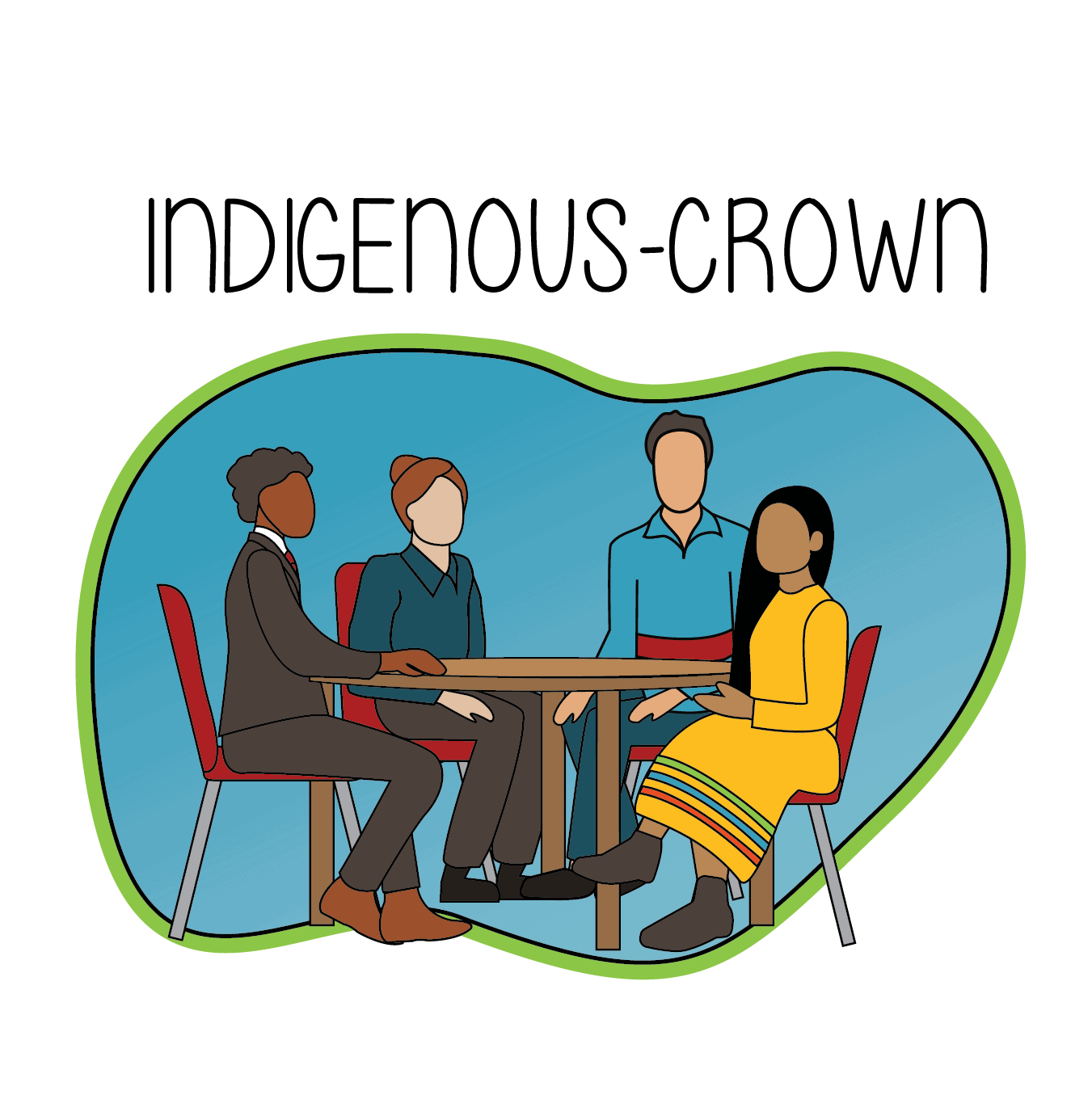
Tongait KakKasuangita SilakKijapvingat / Torngat Mountains National Park
Snapshot
Lead Indigenous Governments: Nunatsiavut Government (representing the Labrador Inuit) and the Makivik Corporation (representing the Nunavik Inuit).
Governance Model: Indigenous-Crown Partnership
Established: Established in 2005. Read more in the Establishment Section.
Location: Northern tip of Nunatsiavut, Labrador Peninsula
Approximate Size: 9,700km2
Quick Facts:
- Administered by Parks Canada but driven by an all-Inuit Co-operative Management Board.
- The Co-operative Management Board makes decisions by consensus.
- Any outstanding issues are sent to the Minister of the Environment and Climate Change.
- The park is accessible to the public only by boat (in the summer), charter plane, or helicopter.
- The park protects culturally important species like the polar bear and caribou along with key Inuit sites.
Vision Statement: This Vision Statement appears in the Management Plan prepared by Parks Canada in collaboration with the Co-operative Management Board:
“Tongait KakKasuangita SilakKijapvinga is a place of rugged coastline, deep fiords, steep mountain ranges – a place where wildlife abounds – awe inspiring landscape of great spiritual importance to Inuit.
Travelling through the land of Inuit, one is struck by the smell of Labrador tea underfoot, the tapestry of colours and textures of the landscape, the speckling of archaeological sites silently conveying stories of the past and the overwhelming feeling that the mountains are alive. Northern lights blaze in the night sky. This is an Inuit homeland described as ‘Alianattuk’ – a good place to be.
Inuit once again use and occupy their traditional places in the Torngat Mountains, reinforcing their connection to the ecological and spiritual elements of this Inuit homeland. Inuit Elders are reunited with old friends and memories as they return to traditional places they knew as children. These memories and the connections Inuit have with the land form the story that is passed on to the youth of the region and shared with Canadians. This is the true testament to the elemental integrity of this environment.
Tongait KakKasuangita SilakKijapvinga is managed in a spirit of partnership and cooperation with Inuit. It is a model of cooperative management where the spiritual significance and the cultural and ecological integrity of the park are protected. Working with Inuit partners, Canadians enjoy, discover and understand the special relationship that Inuit have with this Inuit homeland. The spirit and intent of the establishment of Tongait KakKasuangita SilakKijapvinga is honoured and celebrated.
Great feelings of serenity and community fill those visiting the park as they share a meal of freshly caught Arctic char in a fiord surrounded by snow- capped cliff faces revealing billions of years of the creation of earth, while listening to the sound of the Inuktitut language as Inuit Elders share their stories of life on the land. As a premiere Indigenous tourism experience in the Canadian north, people of different cultural backgrounds come to the Torngat Mountains to learn about and experience the park through Inuit eyes.
Strong relationships with partners and stakeholders provide the opportunity to facilitate exceptional visitor experiences and for Canadians to create personal connections to the park. It is through these relationships that the park contributes to the economic and social well-being of the region. Canadians, from as far away as Montreal and Vancouver, discover and appreciate the beauty and richness of this Inuit homeland from the comforts of their homes, offices and schools.
Inuit open their homeland to Canadians, and together Parks Canada and Inuit partners bring people to the park and the park to Canadians.”
Map:
A map of Tongait KakKasuangita SilakKijapvinga /Torngat Mountains National Park, on the Northern tip of Nunatsiavut, Labrador Peninsula. Source: Parks Canada
Governance Details
Who makes decisions?
Co-operative Management Board (CMB)
The operations of Torngat Mountains National Park are steered by a seven-member Cooperative Management Board (CMB). The CMB consists of two representatives appointed by the Nunatsiavut Government, two representatives appointed by Makivik Corporation, two representatives appointed by Parks Canada, and one chair that is jointly appointed by all three parties.
All members of the CMB are Inuit (at the time of publication). The CMB is non-representative and does not represent the interests of the organization that appoints the members. An all-Inuit CMB ensures that the members approach its mandate through an Inuit cultural lens.
This is the first all-Inuit CMB in the history of Parks Canada. CMB members serve four-year terms, but these can be extended.
The CMB is incorporated as a not-for-profit organization and can receive funding from various sources and manage its own finances.
Diagram: The composition of the Cooperative Management Board (CMB) for Tongait KakKasuangita SilakKijapvinga / Torngat Mountains National Park. This includes two representatives appointed by Nunatsiavut Government, two representatives appointed by Makivik Corporation, two representatives appointed by Parks Canada, and one independent Chair jointly appointed by the three parties. All CMB representatives are currently Inuit (at the time of publication).
How are decision-makers are determined?
There are no formalized policies for selecting board members. Each of the three parties selects two representatives, and these decisions reflect the respective policies of each appointing party. At times, representatives will be selected if they are seen as respected within the communities, including Elders or particularly skilled hunters or travellers, or youth with ties to the land may be chosen to represent the voices of youth.
Parks Canada also chooses representatives for the CMB based on their connection with and knowledge of the land. Although there is no rule that states representatives must be Inuit. In practice, Parks Canada has always selected one Labrador Inuk and one Nunavik Inuk. Parks Canada also tries to ensure they appoint at least one woman to the CMB.
Who are decision-makers are accountable to?
The CMB holds community meetings in Kangiqsualujjuaq (George River) and Nain every six months. However, more could be done to communicate with the communities about the role of the CMB and how community members can participate in meetings. The CMB is inclusive in its decision-making process and will often consult with Nunatsiavut and Nunavik Inuit before making decisions on key issues.
How are decisions made?
The CMB makes decisions by consensus. Decisions are reached through open discussions where interested people or experts are invited to share their perspectives and experience with the issue at hand. The CMB meets twice per year in person, and twice per year virtually or by phone.
On issues relating to Inuit rights, the CMB provides recommendations directly to the Minister of the Environment and Climate Change who must respond to the CMB with reasons for their decision.
If there is a dispute or if implementation is challenging, the issue is taken to the Minister who has final decision-making authority.
On issues relating to the day-to-day operations of the park, the CMB often deals directly with the park superintendent. The current superintendent is an Inuk and has been a great ally to the CMB. In fact, all of the staff in the park are Inuit. The positive working relationship between the CMB and the park has helped to ensure that the CMB’s guidance and recommendations are consistently implemented. To date, Parks Canada has accepted all of the CMB’s recommendations.
Diagram: A diagram of the decision-making process for Tongait KakKasuangita SilakKijapvinga / Torngat Mountains National Park. The Cooperative Management Board makes decisions by consensus and shares its recommendations with the Field Unit Superintendent or the Minister of Environment and Climate Change on issues relating to Inuit rights.
Only one issue has been taken to the Minister and is pending resolution. This issue involves the Torngat Mountains caribou herd, which the government of Canada is considering adding to the Species At Risk list. The CMB has requested to allow for Inuit-led management of the herd instead of listing the species as “at risk.” As this issue has legal implications, it is currently being processed by the Minister.
Laws and Legislation
The park is designated as a federally protected area under the Canada National Parks Act. Parks Canada is therefore responsible for the implementation of the CMB’s recommendations.
The park was established in 2005 as part of the Labrador Inuit Land Claims Agreement, signed between the Labrador Inuit Association, the Government of Canada, and the Government of Newfoundland and Labrador.
This established the Nunatsiavut Government as a political entity representing Labrador Inuit. A condition for establishment was the creation of the CMB. Labrador Inuit and Parks Canada signed the Labrador Inuit Impacts and Benefits Agreement to protect and respect Inuit rights in the park and provide for a role in the management and operation of the park
Makivik Corporation represents Nunavik Inuit and protects Inuit rights and benefits set out in the James Bay and Northern Quebec Agreement (1975). The Nunavik Inuit Land Claims Agreement Act in 2008 provided Nunavik Inuit consent to the creation of the Torngat Mountains National Park as it was an area of overlap for Nunavik Inuit. They also signed a Nunavik Inuit Impacts and Benefits Agreement with Parks Canada like the one signed by the Labrador Inuit.
Each of these agreements provided for the establishment of a CMB and Makivik, the Nunatsiavut Government, and Parks Canada agreed to harmonize the boards rather than have two separate boards.
The Torngat Mountains National Park border is adjacent to the boundary of the Kuururjuaq Parc National in Nunavik, creating a transboundary polar park experience.
Management Plan
The Management Plan reflects the first ten years of collaboration between Parks Canada and the CMB. In these first ten years, the CMB would spend one week per year on the land with Parks Canada, sharing knowledge and building shared objectives for park management.
Until recently, the CMB received funding from Parks Canada to support their administrative needs. Each Party pays the costs of its own appointees including honoraria and travel. Parks Canada also pays the costs for the Chair.
Parks Canada recently increased its funding to the CMB in recognition of their shared priorities. This will allow the CMB to increase its scope of interests and involvement in supporting initiatives that align with its priorities, such as connecting youth with Elders and the land and making the park more accessible to Inuit.
Advantages and Challenges of Governance Model
Advantages
- The all-Inuit CMB ensures that the interests of the land and Inuit beneficiaries are represented.
- The CMB’s status as an independent body, and its arm’s-length relationship with Parks Canada, allows it to operate free of institutional pressure.
- Having equal weighted representation among parties provides balance and ensures the CMB is working in everyone’s common interest.
- Working with Parks Canada means that operations are funded by the federal government, while decisions are driven by the CMB.
Challenges
- As CMB members are often Elders or community members, at times it is challenging to navigate western bureaucratic processes, especially when interpreters are needed.
- The expectations of CMB members can be quite high, especially when asked to make decisions that can affect so many people.
- Working with the federal government can require playing politics and tapering expectations, as the Minister has the ultimate decision-making authority.
- Constant care is required to foster and maintain relationships and trust among the parties and partners
- Due to the geography of the area and the high cost of travelling, the budget needed for meetings is high. It also remains a challenge for all Inuit beneficiaries to access and visit the park.
Further Reading
- Video (2012, Parks Canada): Torngat Mountains National Park: An Inuit Homeland.
- Parks Canada (2022): The Inuit Story: Torngat Mountains National Park.
Establishment
Tongait KakKasuangita SilakKijapvinga, or Torngat Mountains National Park, was established in 2005 as part of the Nunatsiavut land claim agreement. Although the park is administered by Parks Canada, the Nunatsiavut Government (representing the Labrador Inuit) required the creation of a CMB to consent to the creation of the park.
Pursuing protection through Parks Canada was a strategic decision on the part of the Labrador Inuit to protect a greater portion of their territory than would have been protected through the land claim process alone. Given that the territory is significant to the Nunavik Inuit, the Makivik Corporation (representing the Nunavik Inuit) was invited to co-govern the park.
The all-Inuit CMB allows the Inuit to exercise their rights and responsibilities within the territory, while Parks Canada handles funding and operations.
Tongait is the Inuktitut word for “place of spirits,” and the park protects culturally important species like the polar bear and caribou along with key Inuit sites, including burial sites, sod houses, tent circles, and settlement camps.
Additional Context
How Inuit Exercise Rights and Responsibilities
Although travel and access to the park can be challenging, the Inuit maintain their rights to practice their livelihoods throughout the park. The all-Inuit board and all-Inuit park staff ensure that Inuit priorities, knowledge, and culture are integral to the management of the park.

Eeyou Istchee Protected Area Network
Snapshot
Lead Government: Cree Nation Government (CNG) and Grand Council of the Crees.
Read more about Cree communities in the Additional Context Section.
Governance Model: Nation-to-Nation (variation of Indigenous-Crown Partnership)
Established: Proposed in 2018, finalized in 2020. Read more in the Establishment Section.
Location: Eeyou Istchee, north-western Québec.
Approximate Size: 39,000km2
Quick Facts:
- Cree communities drove the creation of the Cree Regional Conservation Strategy, a framework for establishing protected areas in Eeyou Istchee.
- The CNG and the Government of Québec finalized the protected area network, which was selected by Cree communities, under the Grande Alliance
- Twenty-three percent of Eeyou Istchee is protected, with plans to add other conservation measures for a total of 50 percent by 2035.
- The long-term governance model for the network will soon be negotiated.
Vision Statement:
“Our Vision is to maintain strong ties to the Cree cultural heritage and way of life, and sustain biodiversity by creating a large, interconnected network of conservation areas in Eeyou Istchee.”
Read the full vision statement.
Website: https://www.eeyouconservation.com/
Map:
A map of Eeyou Istchee Protected Areas Network. Source: Cree National Government.
Governance Details
Who makes decisions?
The details of how the parks will be governed are being worked out. The CNG hired the Firelight Group to investigate different types of Indigenous-led management and co-governance arrangements. Members of the CNG are considering what model would be best for Eeyou Istchee and will negotiate management details with the Province of Québec. According to Chantal Otter Tetreault, Protected Areas and Conservation Specialist at CNG:
“What type of modelling… we’re not sure yet, it’s too premature. But we know that we do have the capacity. We do have the governance level to oversee and manage our own areas.”
Developed in 2015, the Cree Regional Conservation Strategy (CRCS) is the Cree framework for protected area establishment in Eeyou Istchee. The CRCS guided the process for determining areas for protection, as well as which type of legislation would best meet the conservation needs, such as proposals for Québec national parks or biodiversity reserves.
Read more about who was involved in that process in the Establishment Section.
Tallymen
There are three hundred traplines (or family hunting areas) in Eeyou Istchee which are managed by Cree tallymen. The tallymen are responsible for supervising activities related to the right to harvest on a Cree trapline. There is typically one tallyman per trapline, but in some cases there can be up to four tallymen per trapline. . Tallymen make most of the decisions related to conservation as part of the Cree trapline management system. This system will be the foundation of protected area management planning.
The Cree-Quebec Environment Table and Grande Alliance
The CNG and the Government of Québec collaborated on the protected area network at the Cree-Québec Environment Table from 2016 until the Grande Alliance Memorandum of Understanding was signed in 2019. The Grande Alliance is a commitment to a 30-year partnership between the two governments to develop infrastructure and establish protected areas. The Grande Alliance finalized the 39,000km2 protected area network that was negotiated at the Cree-Québec Environment Table.
The former CNG Deputy Grand Chief and the Deputy Minister of the Environment sat at the head of the Cree-Quebec Environment Table. The Deputy Minister had an Associate Deputy Minister and the CNG Deputy Grand Chief had four CNG support staff.
The Grande Alliance included three CNG directors and two Ministers, with technical support from other CNG Directors and staff. A new table was created ,called the Bilateral Table, that meets to discuss next steps for management of the protected areas.
CNG Protected Areas Team/Challenge Fund Team
The CNG Protected Areas team and Challenge Fund Team have developed projects with Cree communities centred on three streams: Cree culture, water, and wildlife. The projects include a marten monitoring program, a Cree cultural information project, and a water quality monitoring project.
Their work is funded through the Pathway to Target 1 Challenge Fund, which was matched at 20 cents per dollar by the Province of Québec and other private donors. The results of these studies will help to inform decision-making around the management of the protected areas, which is currently being discussed by the Bilateral Table.
Who are decision-makers accountable to?
The Deputy Grand Chief, who sat on the Cree-Environment Table, is elected and accountable to the Cree Nation membership. The CNG staff who also sit on the various tables are employees, many of whom have occupied their positions for many years. While the negotiations are not always as transparent as community members might like, the decisions around which areas to propose for protection were made at the community level. The CNG staff then relayed this information to the relevant Ministers. Ongoing community engagement keeps decision-makers accountable to community needs.
How are decisions made?
The Bilateral Table is deliberating on what kind of management model the CNG would like to see in the protected area network, based on information from the Firelight Group.
One potential model could involve the CNG creating a corporation to oversee the management of the protected areas. The corporation could include board members and a team of park managers, including Indigenous Guardians, for every protected area. The Province of Québec could then provide funding to this corporation, which would carry out the day-to-day management operations.
Laws and Legislation
The Eeyou Istchee Protected Area Network protects Cree rights and fulfils Cree responsibilities to protect the lands, waters, and wildlife in the territory. Cree rights are protected under Section 35 of the Canadian Constitution and the following series of agreements with the governments of Québec and Canada:
| Date | Name of Agreement | Details of Agreement |
|---|---|---|
| 1975 | James Bay and Northern Quebec Agreement (JBNQA) |
|
| 1978 | Development of The Cree Nation Government (CNG) and Grand Council of the Crees |
|
| 2002 | Paix des Braves/ Cree- Quebec New Relationship Agreement |
|
| 2008 | Cree-Canada New Relationship Agreement and Cree Constitution |
|
| 2010 | Eeyou Marine Land Claims Agreement |
|
| 2012 | The Governance Agreement |
|
Table: A timeline of significant agreements between the Cree and the Crown in Eeyou Istchee.
The protected area network will be designated under Québec law and will include Québec national parks and biodiversity reserves. Cree rights to hunt, trap, and practice the Cree way of life are upheld in the entire protected area network. Cree conservation rights are also protected under the United Nations Declaration on the Rights of Indigenous Peoples, as well as Article 8j (and others) in the United Nations Convention on Biodiversity.
The Province of Québec passed Bill 46 in 2021, which introduced Aboriginal protected areas as a new protection status. Québec is one of the first provinces to create a legal category for Aboriginal protected areas. It is yet unclear how this category will shape the long-term governance model of the Eeyou Istchee Protected Area Network.
Management Plan
A management planning process is underway, guided by the Cree Regional Conservation Strategy. Read more about this process in the Establishment Section.
The Cree Regional Conservation Strategy is using watershed-based planning to create protected areas based on water flow. This approach prioritizes conserving the headwaters to reduce the risk of contamination or pollution from development outside of the protected areas. Watershed-based planning ensures the protection of culturally important lakes and rivers for travel, subsistence harvesting, and spiritual purposes.
The management plans will also prioritize caribou conservation and recovery. This is of key importance to the CNG, as the woodland caribou is a cultural keystone species for the Crees in Eeyou Istchee.
Conservation planning must account for different levels of development and varying impacts of resource extraction throughout the territory. Below the northern limit for commercial forestry, much of the land has been impacted by forestry, roads, and mining activity. The northern part of Eeyou Istchee has been heavily impacted by hydroelectric development along with some mining development.
Advantages and Challenges of Governance Model
Advantages
- Having protected areas designated under Québec law gives an extra layer of protection against unwanted development.
- Communities decided which areas were to be protected, building upon the Cree trapline management system. This means communities will be directly involved in managing their own land.
- Protection will support communities in healing on the land and developing a conservation economy.
Challenges
- Finding the capacity to build a management team for each protected area.
- Translating what happens in negotiations to community members.
- Securing long-term funding and financing solutions.
Advice
Chantal Otter Tetreault, Protected Areas and Conservation Specialist, CNG, offers advice for other IPCA initiatives. To listen, click on the white play button below.
Transcript:
“Some of our older protected areas were based on just cultural values, and as much as Quebec appreciates or respects that, they do need to look at it through an environmental lens.
So, they were really happy with our approach where we married both the cultural and the environmental important areas.
So, we met them more than halfway. We actually went and actually did the work for them to kind of integrate that environmental features, ecological features, into our proposals. So, for other First Nations, I would really have them reach out to Nature Conservancy [of] Canada (NCC) who helped us with these proposals.
…With NCC we’re developing pamphlets, and that’s pretty much what those pamphlets are, to say “look what we did, this is how we did it, very easy to do, and try it out.”
Because I think that was the best way, really working with watersheds. The importance of watersheds is there…it’s what feeds everything. So, I really like that approach that we used. It highlighted the cultural data too.”
Further Reading
- Story Map: Protected Areas and Conservation Planning in Eeyou Istchee.
- Eeyou Conservation Resources
- CBC News (2018): Cree Nation identifies 30 per cent of its territory in conservation wish list
- Press Release (2020): The Grande Alliance is protecting more than 20% of the Eeyou Istchee James Bay Territory.
Establishment
Cree Regional Conservation Strategy
In 2015, the Cree Nation Government (CNG) developed the Cree Regional Conservation Strategy (CRCS) to provide a framework for the establishment of a protected area network in Eeyou Istchee. The CRCS was developed by the Eeyou Protected Areas Committee. This Committee included representatives from all 10 Cree communities, along with members from the Cree Trappers Association, Cree Nation Youth Council, and the CNG (Environment and Remedial Works Department and the Culture and Language Department).
The CRCS respectfully integrates Cree traditional knowledge and western scientific knowledge, which will guide all Cree conservation work. The development of the strategy involved community-level consultations and planning sessions with tallymen and land users to identify priority cultural and ecological conservation areas. The CRCS aims to ensure respect for Cree rights and protect Cree lands, waters, and resources for current and future generations.
Community Engagement included:
- Recording and mapping Cree cultural values (camps, travel routes, burial/birth sites, important fishing lakes and wildlife areas, historical sites and sacred areas, etc.)
- Using Cree cultural features and computer modelling software to identify, prioritize, and rank candidate protected areas.
- Sharing options with communities and making changes to boundaries of protected area proposals.
The CNG partnered with the Nature Conservancy of Canada (NCC) to outline key considerations for conservation planning. Final decisions on areas to protect were made by the communities following several community engagement sessions. The CNG then submitted a proposed network of protected areas to the Ministère de l’Environnement et de la Lutte contre les Changements Climatiques (MELCC) in 2018.
In 2020, the CNG and the Government of Québec signed the MOU for the Grande Alliance where they committed to continue the Plan Nord conservation goals to protect 50 percent of the Cree territory by 2035. Québec officially designated 39,000km2 as part of the protected area network in 2020.
Additional Context
Cree Communities
Eeyou Istchee means “the people’s land” in the Cree language. It is an area of approximately 400,000km2 in northwestern Québec and includes ten Cree communities (a population of about 18,000 people).
The five coastal communities are Waskaganish, Eastmain, Wemindji, Chisasibi, and Whapmagoostui. The five inland communities are Waswanipi, Washaw-Sibi, Nemaska, Oujé-Bougoumou, and Mistissini. The southern part of Eeyou Istchee is shared with non-Cree residents.
Alliances and Partnerships
The CNG partnered with the Nature Conservancy of Canada (NCC) in 2015 to support the development of the CRCS. NCC developed spatial datasets for conservation planning and identified options for protected area networks in Eeyou Istchee.
The CNG is also working with the Cree Outfitting and Tourism Association to study the feasibility of developing Cree-led ecotourism in the protected area network.
Indigenous Guardians Program
The Eeyou Istchee Land Keepers program aims to provide sustainable, on-the-land jobs for Cree people. There are four Lands Keepers out on the land patrolling the entire territory, and not just the protected areas (at time of publication).
The program is slowly building, and the goal is to have two Land Keepers per community (for a total of 20) in the next few years. Land Keepers help tallymen and wildlife protection staff to monitor, protect, and manage the land and wildlife as well as fulfil cultural responsibilities.
How Cree Peoples Exercise Rights and Responsibilities
Crees exercise their rights to hunt, trap, fish, and practice the Cree way of life in the protected area network.


